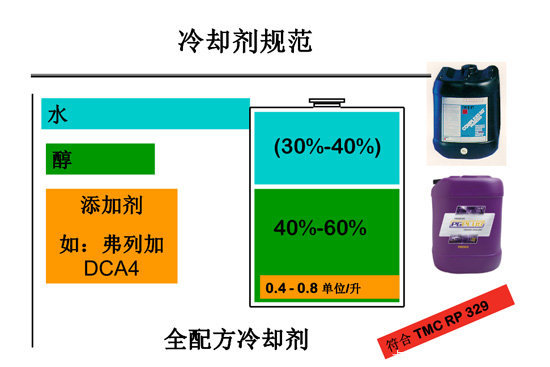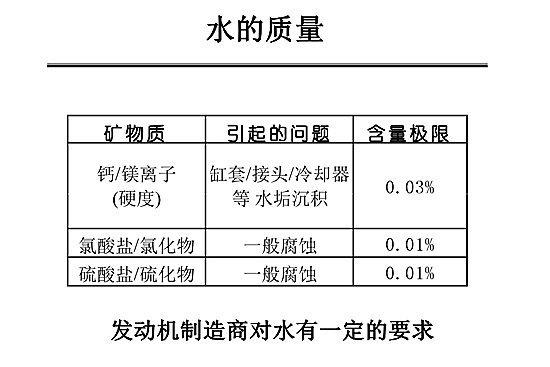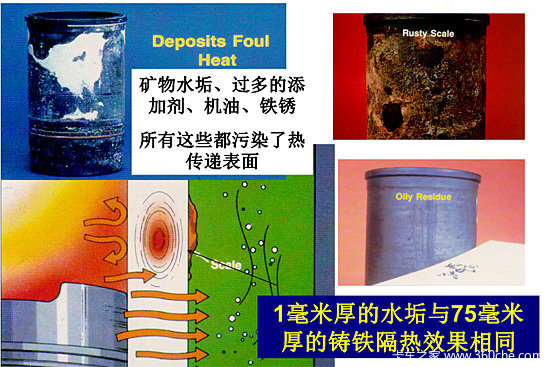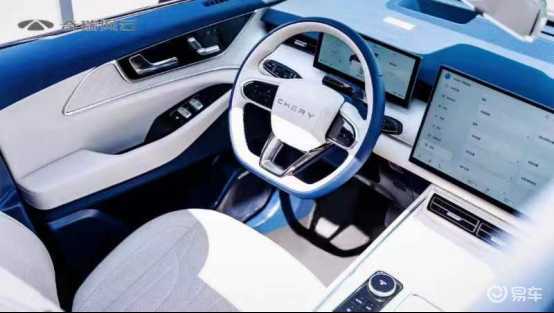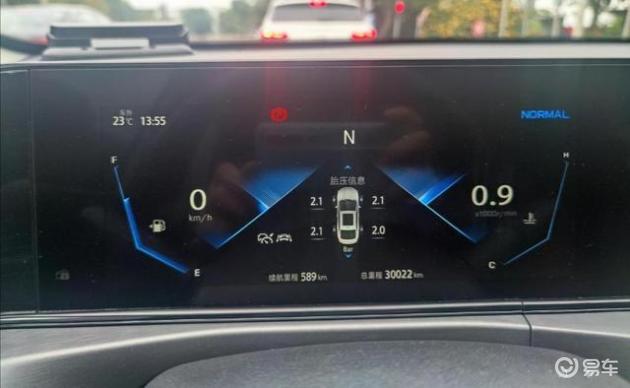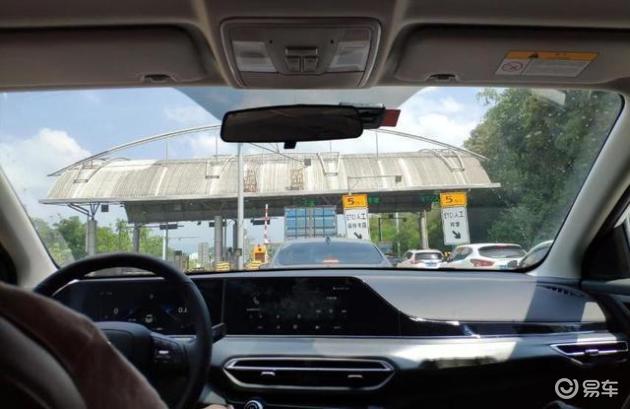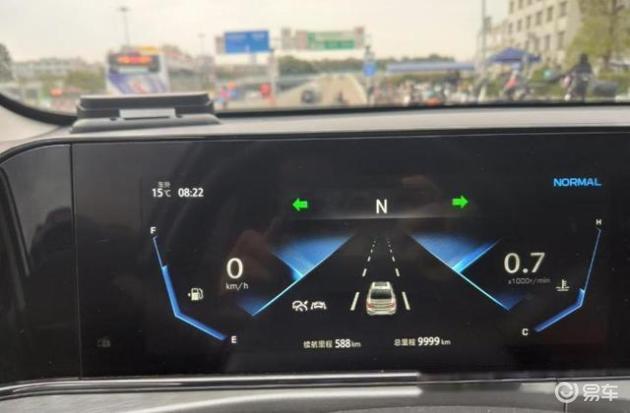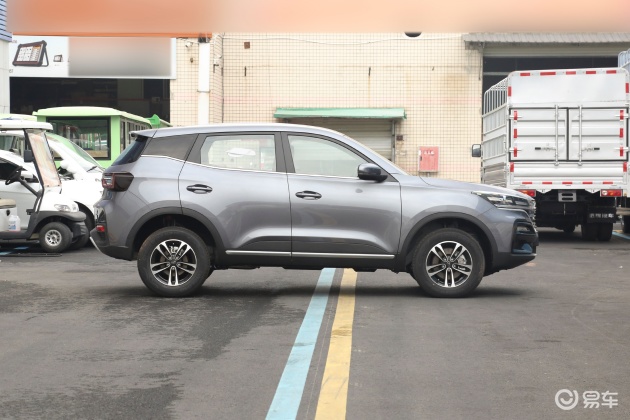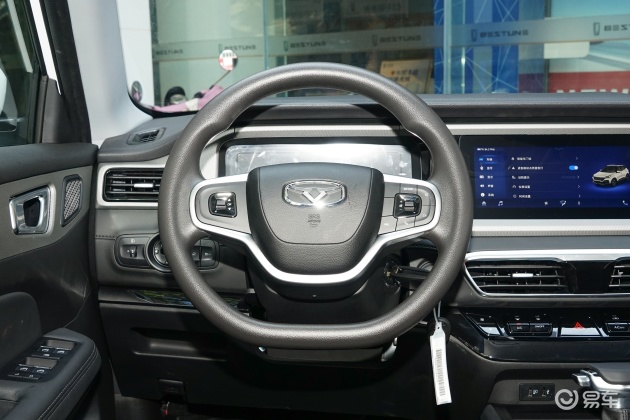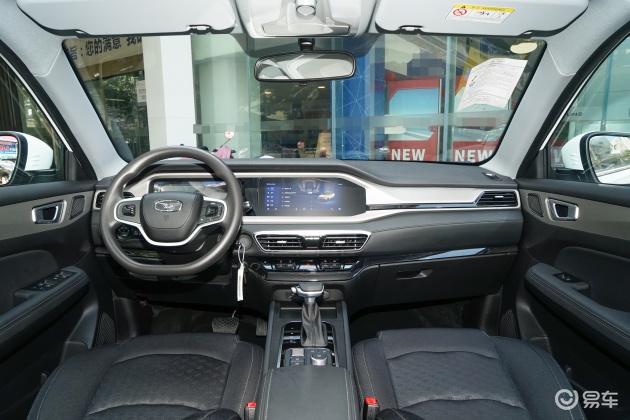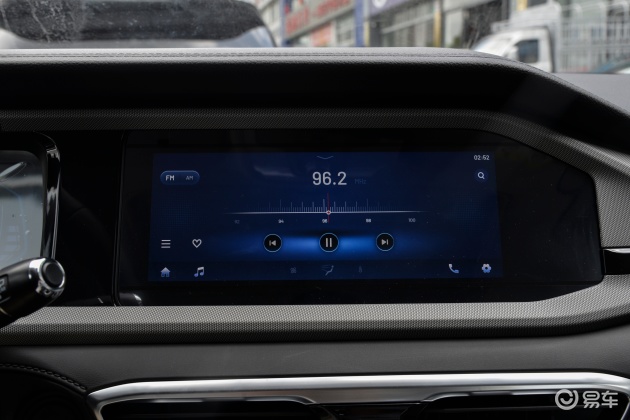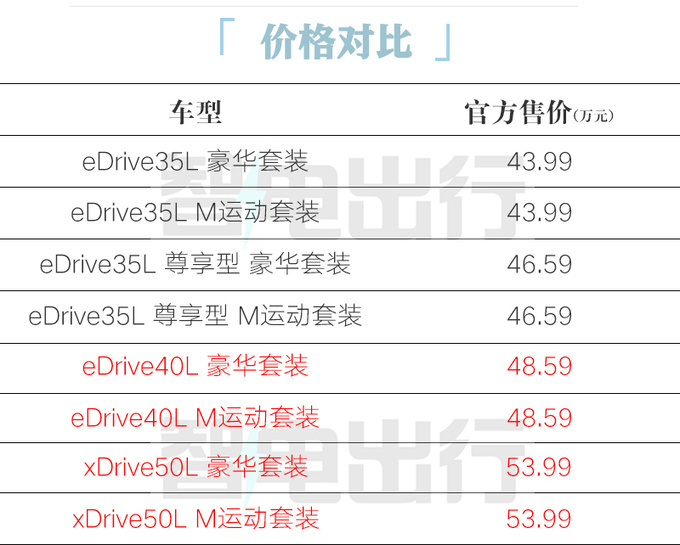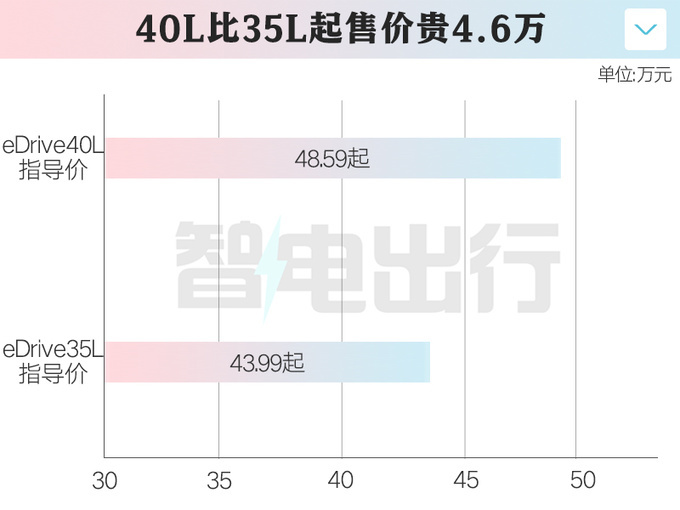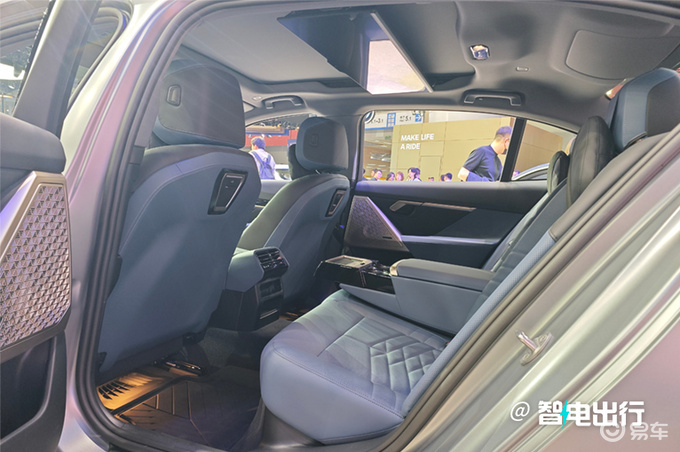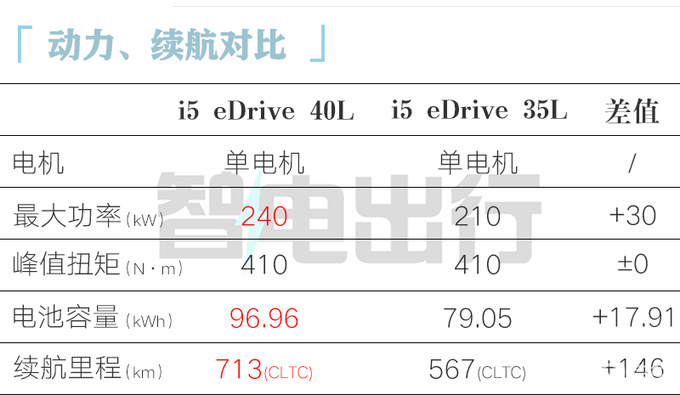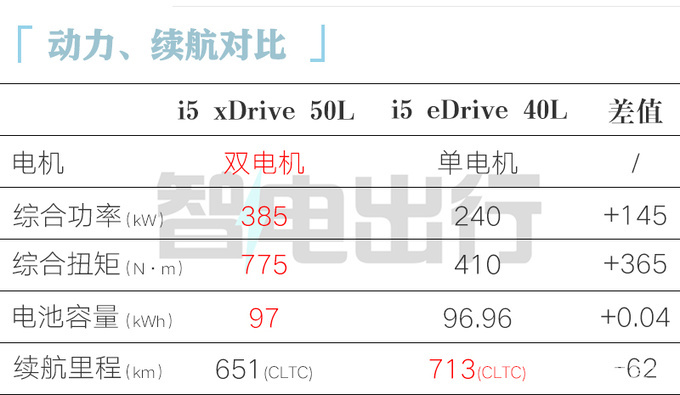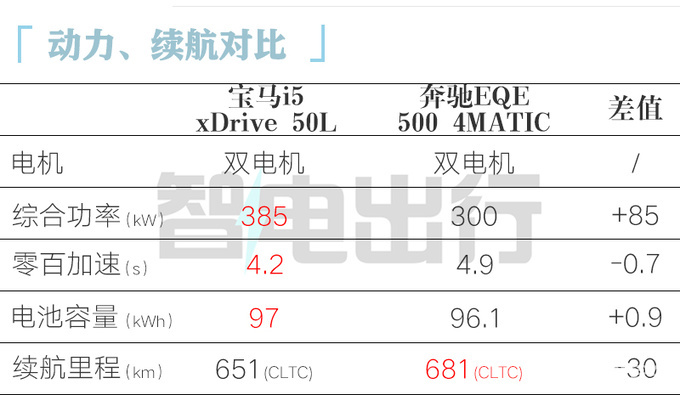[car home Information] In April, the price war of car companies continued. After the price reduction tide in late February and March, the price of the models that had dropped to the end in advance basically stabilized or only slightly adjusted, and some car companies that were waiting to see also chose to join the price reduction army. Consumers began to get used to the tide of price reduction, from the initial wait-and-see state to the opportunity to start consumption, which also made the sales of car companies change obviously in April, and many car companies’ sales rose red, so let’s take a look at the sales list in April to see which car companies’ sales rose sharply.
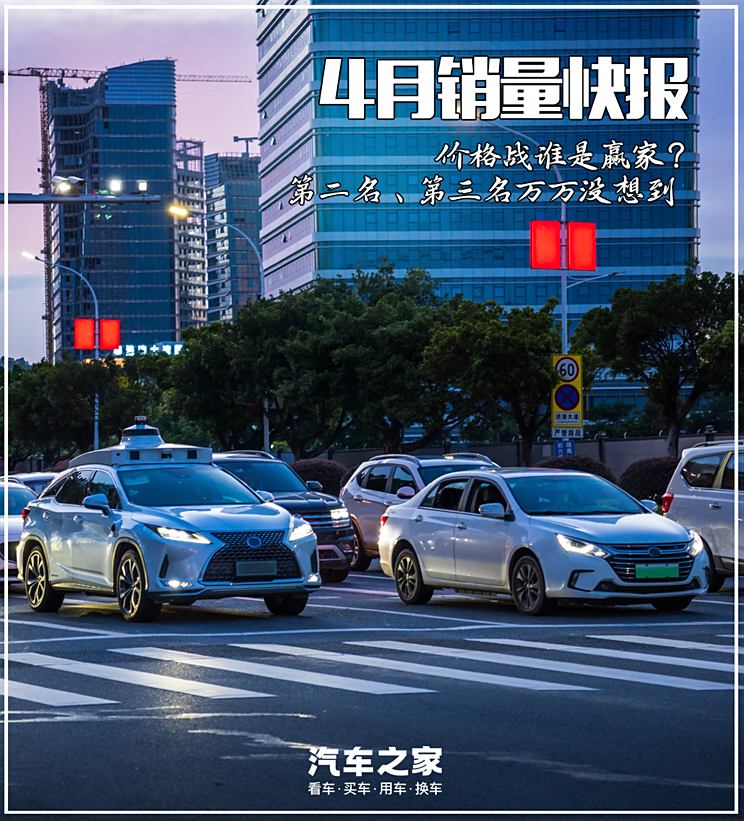
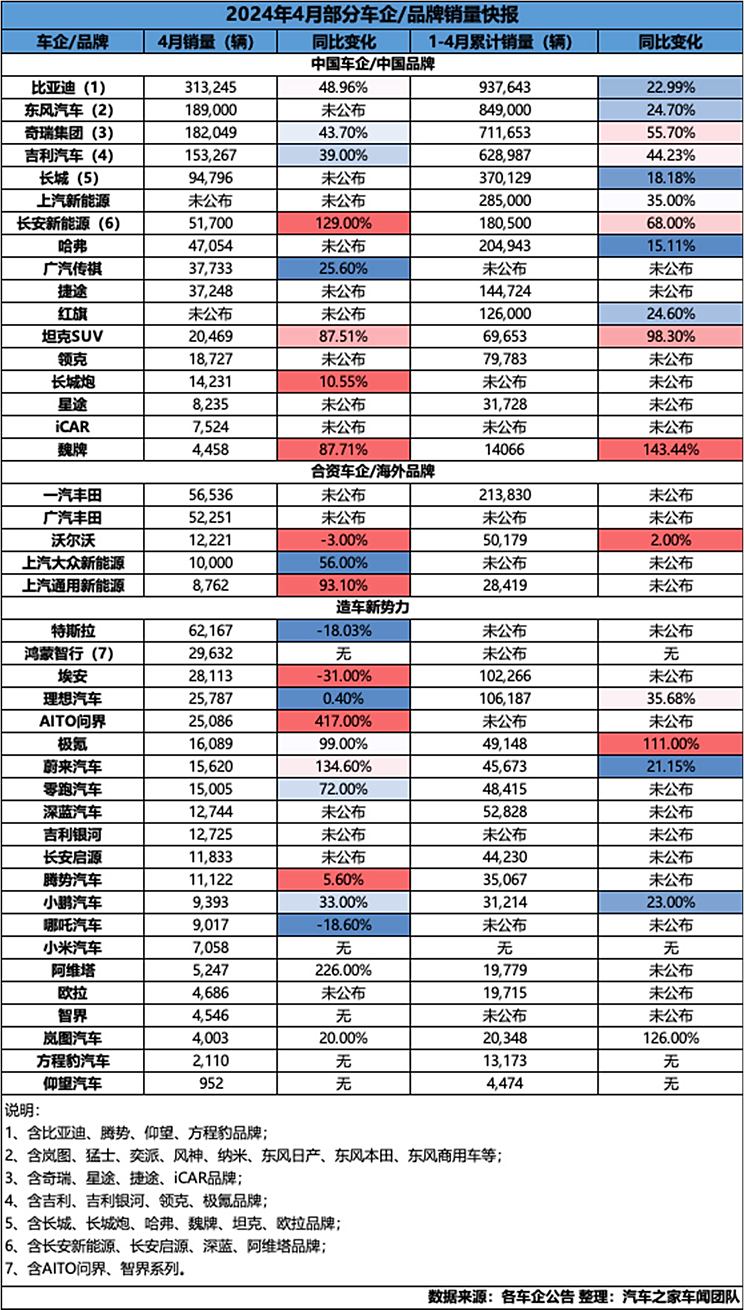
● China car companies/China brands:
In terms of car companies in China, BYD continued to lead the way, and its sales in the first four months were close to one million units. Dongfeng Motor, Chery Group and Geely Automobile entered the second echelon, but it should be noted that the sales volume of Dongfeng Motor includes the sales data of its joint venture company, and its own brand sold 446,000 vehicles from January to April, accounting for about half. We noticed that BYD, Chery Group and Geely Automobile all achieved high year-on-year growth in April. The Great Wall ranked third, with sales of 94,796 units in April.
China brand, Haval, Guangzhou Automobile Chuanqi, Jietu and other traditional family car brands still have good sales performance. At the same time, we have seen luxury or mid-to-high-end brands such as Hongqi, tank SUV and Lectra, which have also been recognized by consumers, and tank SUVs have achieved rapid growth.
Byd
BYD sold 313,245 vehicles and 312,048 passenger cars in April, up 49% year-on-year. At present, the cumulative sales volume of BYD’s new energy exceeds 7.3 million. Details are as follows:
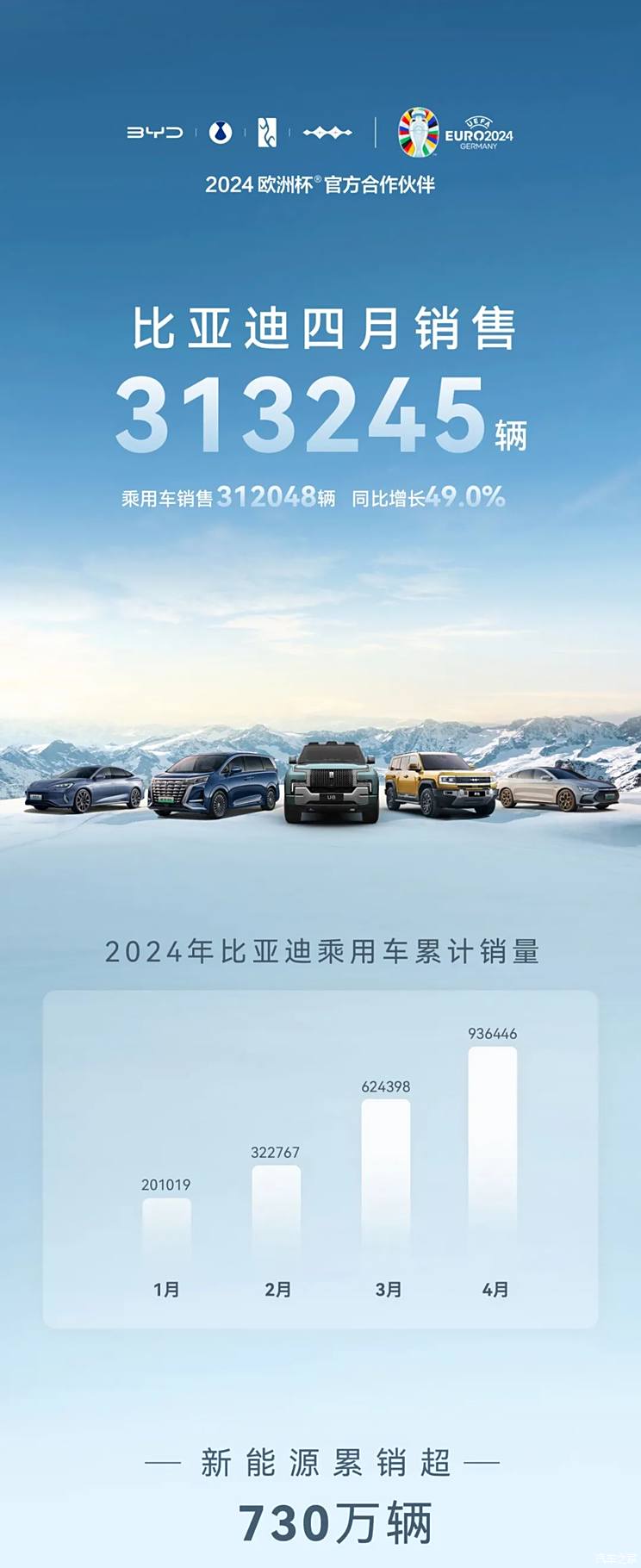



Specifically, BYD Auto sold 297,864 vehicles in April, a year-on-year increase of 49.7%. Tengshi automobile sold 11122 vehicles, looking up to 952 vehicles and Equation Leopard automobile 2110 vehicles. 41,011 passenger cars were exported, up 176.6% year-on-year.
Previously, BYD set the internal sales target of Dynasty and Ocean Net in 2024, with the sales target of Dynasty Net being 1.7 million and Ocean Net being 1.6 million. This goal does not include overseas markets.
○ Dongfeng Motor
From January to April, Dongfeng Motor Company sold a total of 849,000 new cars, a year-on-year increase of 24.7%. Among them, the sales volume of self-owned brand vehicles was 446,000, a year-on-year increase of 46.6%; The sales volume of new energy vehicles was 235,000 units, a year-on-year increase of 132%; The export vehicle sales volume was 71,000 units, up 8.2% year-on-year.
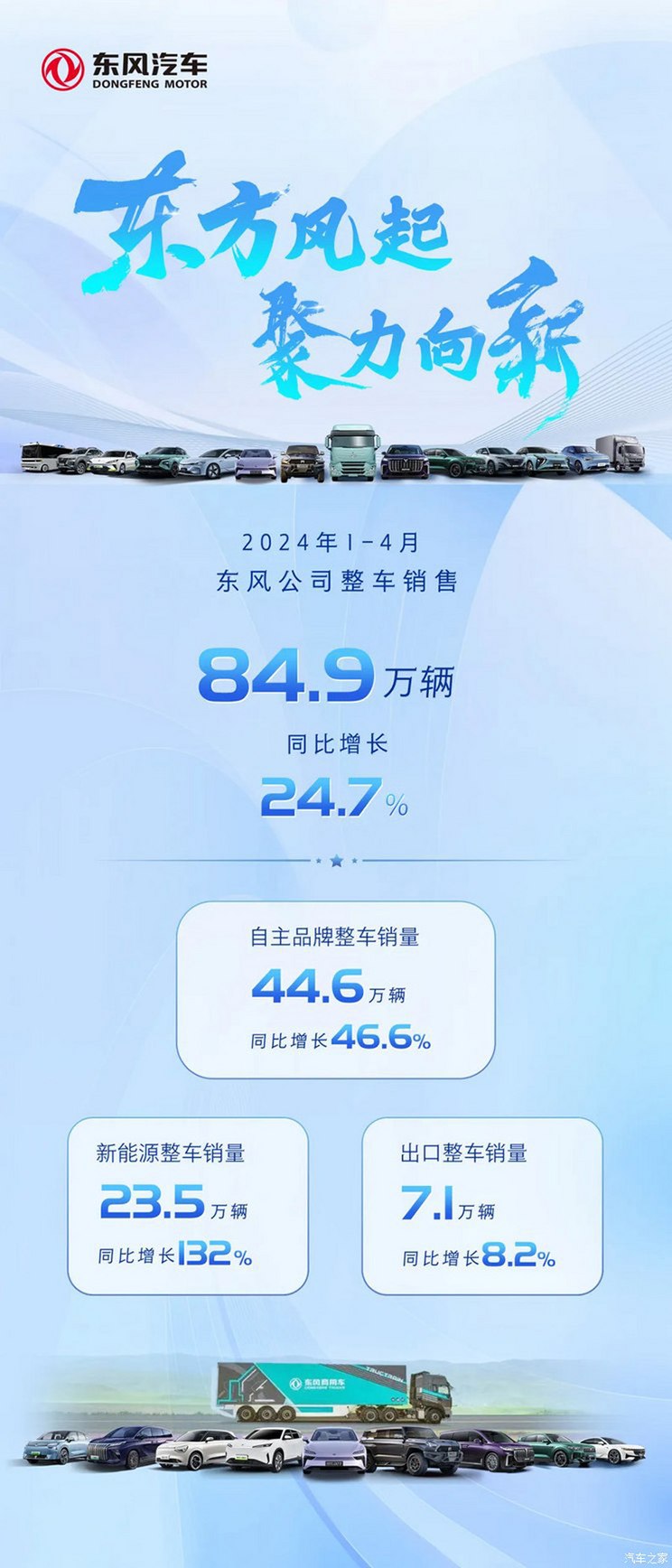
Chery group
Chery Holding Group sold 182,049 vehicles in April, a year-on-year increase of 43.7%; Among them, 89,377 vehicles were exported, up 18.3% year-on-year; The sales volume of new energy was 32,995 vehicles, a year-on-year increase of 165.2%. From January to April, a total of 711,653 vehicles were sold, a year-on-year increase of 55.7%.

According to the official, the sales volume of Chery Group maintained a rapid growth trend. In the first quarter, Chery Group ranked first in the industry with a growth rate of 60.3%. In April, the Federation predicted that the retail sales of passenger cars in narrow sense would drop by 1.5% year-on-year, and Chery Group continued to rise against the trend with a positive growth of 43.7%. From January to April, 93,128 new energy vehicles were sold, a year-on-year increase of 137.3%. From January to April, a total of 342,795 vehicles were exported, up 34.2% year-on-year.
Specific to the brand, Chery brand sold 117,726 vehicles in April; From January to April, the sales volume was 482,947 vehicles, a year-on-year increase of 57.5%. Xingtu brand sold 8235 vehicles in April; From January to April, the sales volume was 31,728 vehicles, a year-on-year increase of 28%; Jietu brand sold 37,248 vehicles in April; From January to April, the sales volume was 144,724 vehicles, a year-on-year increase of 104%; ICAR 03, the first product of Icar brand, has just been on the market for 2 months, and it is loved by cool young people. In April, it sold 7524 vehicles. The cumulative sales volume is 13,011 vehicles.
Geely automobile
Geely Automobile sold 153,267 vehicles in April, up about 2% month-on-month and 39% year-on-year. In April, the sales volume of new energy was 51,428 vehicles, an increase of about 75% year-on-year. In April, the sales volume of overseas exports was 38,151 vehicles, an increase of about 75%.

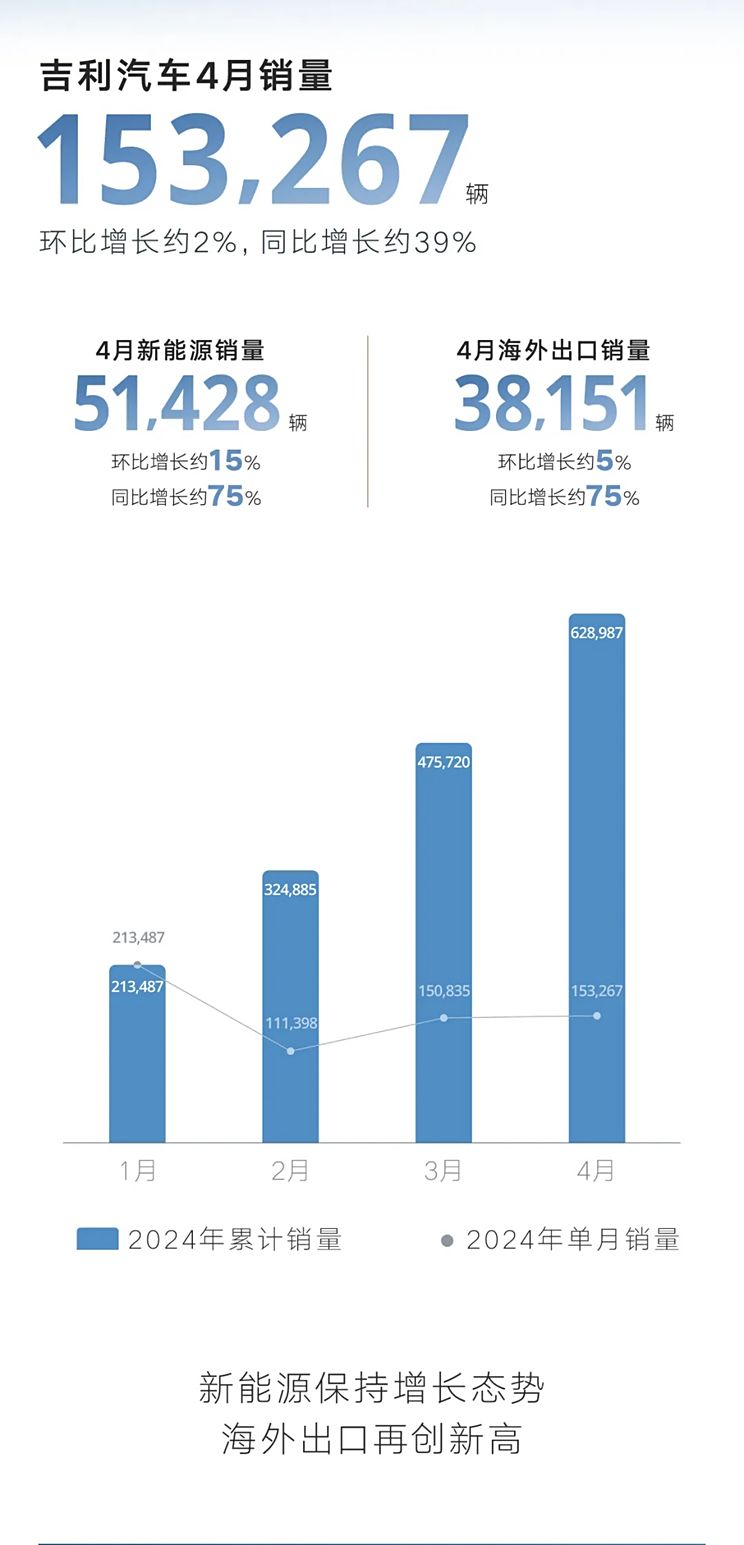



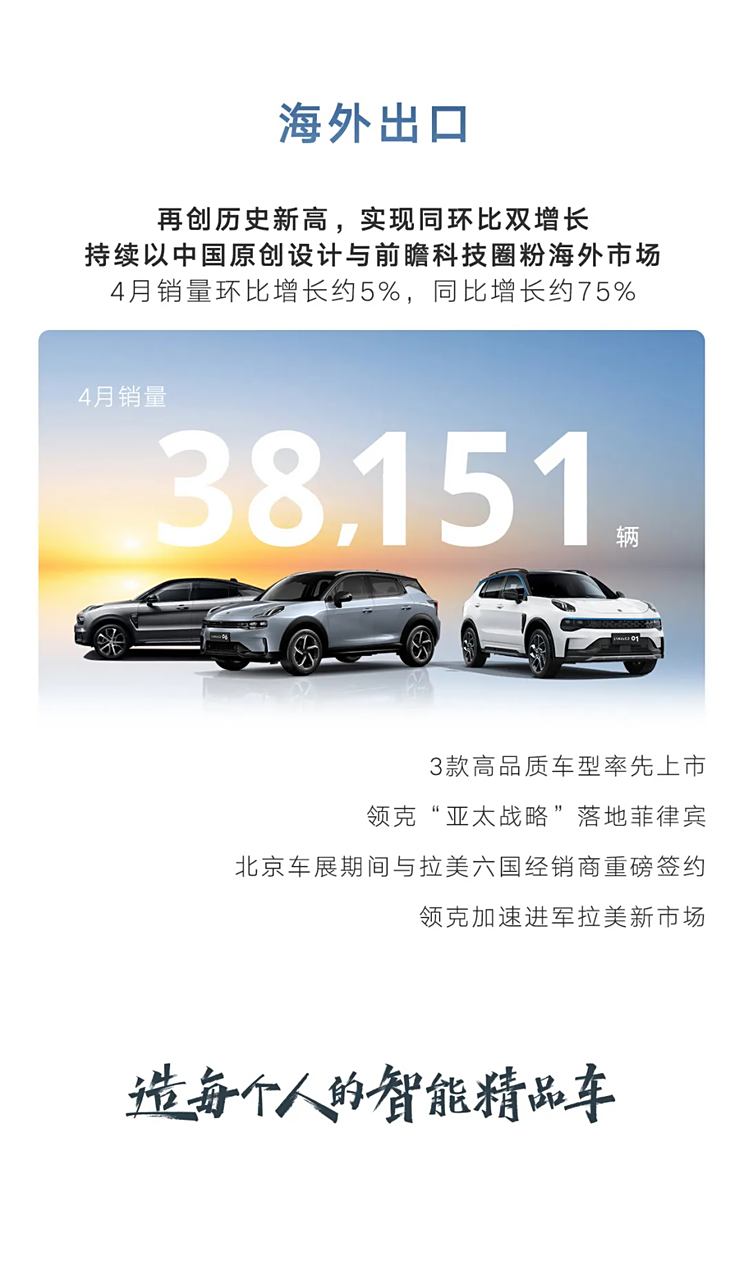
It is reported that Geely Galaxy sold 12,725 vehicles in April, an increase of about 25% from the previous month; The sales volume of Lectra brand in April was 18,727 vehicles, an increase of about 34% year-on-year; The sales volume of Krypton brand in April was 16,089 vehicles, a year-on-year increase of 99%. In terms of overseas exports, the sales volume in April was 38,151 vehicles, an increase of about 5% from the previous month and an increase of about 75% from the same period last year.
Great wall
In April, Great Wall Motor sold 94,796 new cars (compared with 100,276 in March). Among them, 36,141 vehicles were sold overseas, a year-on-year increase of 65.68%, a record high; New energy sales reached 22,436 vehicles, a year-on-year increase of 50.94%; From January to April, Great Wall Motor sold a total of 370,129 new cars, up 18.18% year-on-year.

The Haval brand sold 47,054 new cars in April; From January to April, a total of 204,943 new cars were sold, up 15.11% year-on-year. In April, the 2024 Haval Raptors were launched, and the new generation Haval H6 and H9 made their world debut during the 2024 Beijing Auto Show, which attracted wide attention. Wei brand sold 4,458 new cars in April, an increase of 87.71% year-on-year; From January to April, it sold 14,066 vehicles, up 143.44% year-on-year.

Tank SUVs sold 20,469 new cars in April, an increase of 87.51% year-on-year; From January to April, 69,653 new cars were sold, a year-on-year increase of 98.30%. According to official data, tank brands have occupied more than 50% of the hard-core off-road market for 40 consecutive months. Great Wall pickup trucks sold 18,069 new cars in April, and accumulated 61,564 vehicles from January to April. Great Wall Gun sold 14,231 new cars in April, up 10.55% year-on-year. During the 2024 Beijing Auto Show, 2.4T passenger guns and 2.4T commercial guns were officially opened for pre-sale.

The Euler brand sold 4686 new cars in April; From January to April, the cumulative sales reached 19,715 vehicles. In the next three years, in the global product layout, Euler will develop from the models on sale to the full coverage of small to medium and large, and all the dual product lines of cars and SUVs will go to sea. In April, Great Wall Motor sold 36,141 new cars overseas, a year-on-year increase of 65.68%; From January to April, 128,919 new cars were sold overseas, a year-on-year increase of 74.71%. Up to now, the five brands of Great Wall Motor have all reached the sea, and the world has gained the favor of more than 14 million users.
○ SAIC New Energy
From January to April, SAIC sold 285,000 new energy vehicles, a year-on-year increase of over 35%. The details are as follows:
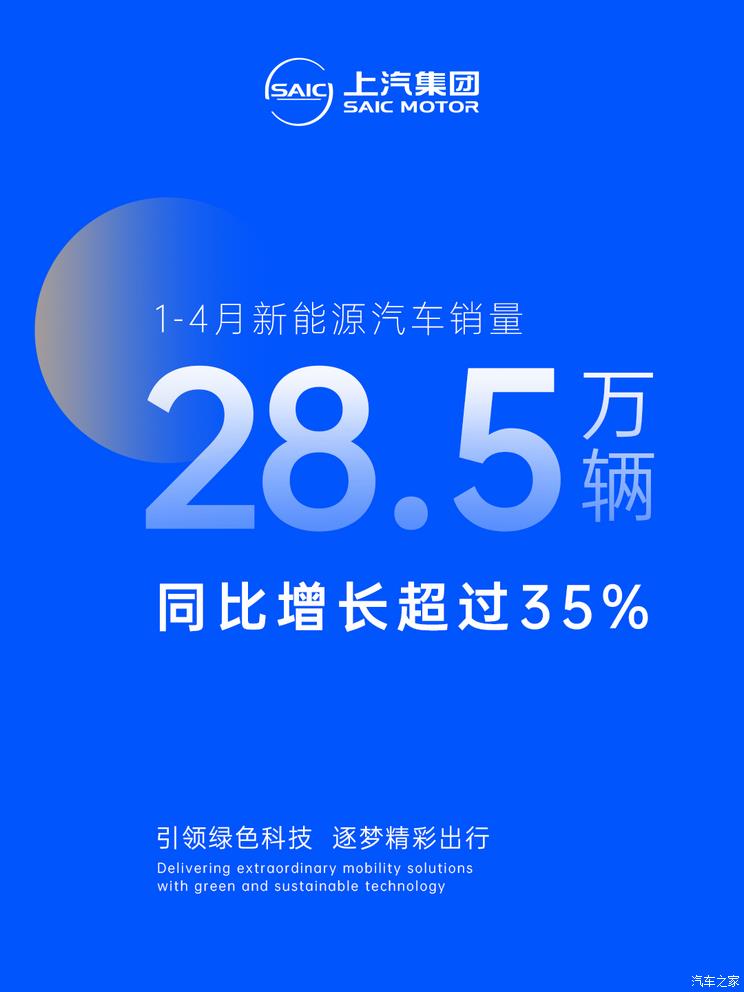
From January to March, the delivery volume of SAIC terminals reached 1.132 million, a year-on-year increase of 9.3%; The domestic market sales of new energy vehicles reached 168,000 units, up 117.5% year-on-year; Terminal deliveries in overseas markets reached 269,000 vehicles, up 21.3% year-on-year. The total operating income of the Group is 143.07 billion yuan, and the net profit attributable to shareholders of listed companies is 2.71 billion yuan.
○ Changan New Energy
From January to April 2024, Changan Automobile sold 180,500 new energy vehicles of its own brand, a year-on-year increase of over 68%. In April, the sales volume of new energy was 51,700 units, a year-on-year increase of over 129%.


Specifically, Changan Qiyuan delivered 11,833 vehicles in April, and the cumulative sales volume of Changan Qiyuan exceeded 88,000 vehicles. Deep Blue delivered 12,744 vehicles in April, and Aouita delivered 5,247 vehicles in April.
A few days ago, Changan Automobile released a financial report showing that in the first quarter of 2024, Changan Automobile’s operating income was 37.023 billion yuan, a year-on-year increase of 7.14%; The net profit of returning to the mother was 1.158 billion yuan, down 83.39% year-on-year.
The data shows that Changan Automobile sold 692,100 vehicles in the first quarter, up 13.9% year-on-year; The sales volume of self-owned brand new energy vehicles was 128,800, a year-on-year increase of 52.4%. Among them, Changan Qiyuan, Aouita and Shenlan Automobile sold 32,379 vehicles, 14,532 vehicles and 40,084 vehicles respectively in the first quarter, accounting for nearly 70% of Changan Automobile’s own brand new energy sales.
It is worth mentioning that Changan Automobile’s investment income in the first quarter was 177 million yuan, down 96.43% year-on-year. Changan Automobile said that it was mainly due to the acquisition of Deep Blue Automobile in the same period last year to confirm the impact of investment income. It is reported that in the first quarter of 2023, Changan Automobile gained 5.021 billion yuan by increasing the shareholding of Deep Blue Automobile.
Looking forward to the whole year of 2024, Changan Automobile aims to produce and sell 2.65 million vehicles and promote the expansion of the market. To this end, Changan Automobile will launch eight new energy products including Aouita E15 and E16 and Changan Qiyuan E07, providing strong product support and further expanding the product supply structure.
○ GAC Chuanqi
GAC Chuanqi sold a total of 37,733 new cars in April, a year-on-year increase of 25.6%. Among them, MPV models sold 13,198 units in April, an increase of 18% year-on-year. Shadow series sold 12,817 units in April, and GS3 sold 10,157 units at movie speed.

Red flag
From January to April, the cumulative wholesale sales of Hongqi brand exceeded 130,300 units, a year-on-year increase of 56.9%. Retail sales exceeded 126,000 units, a year-on-year increase of 24.6%.
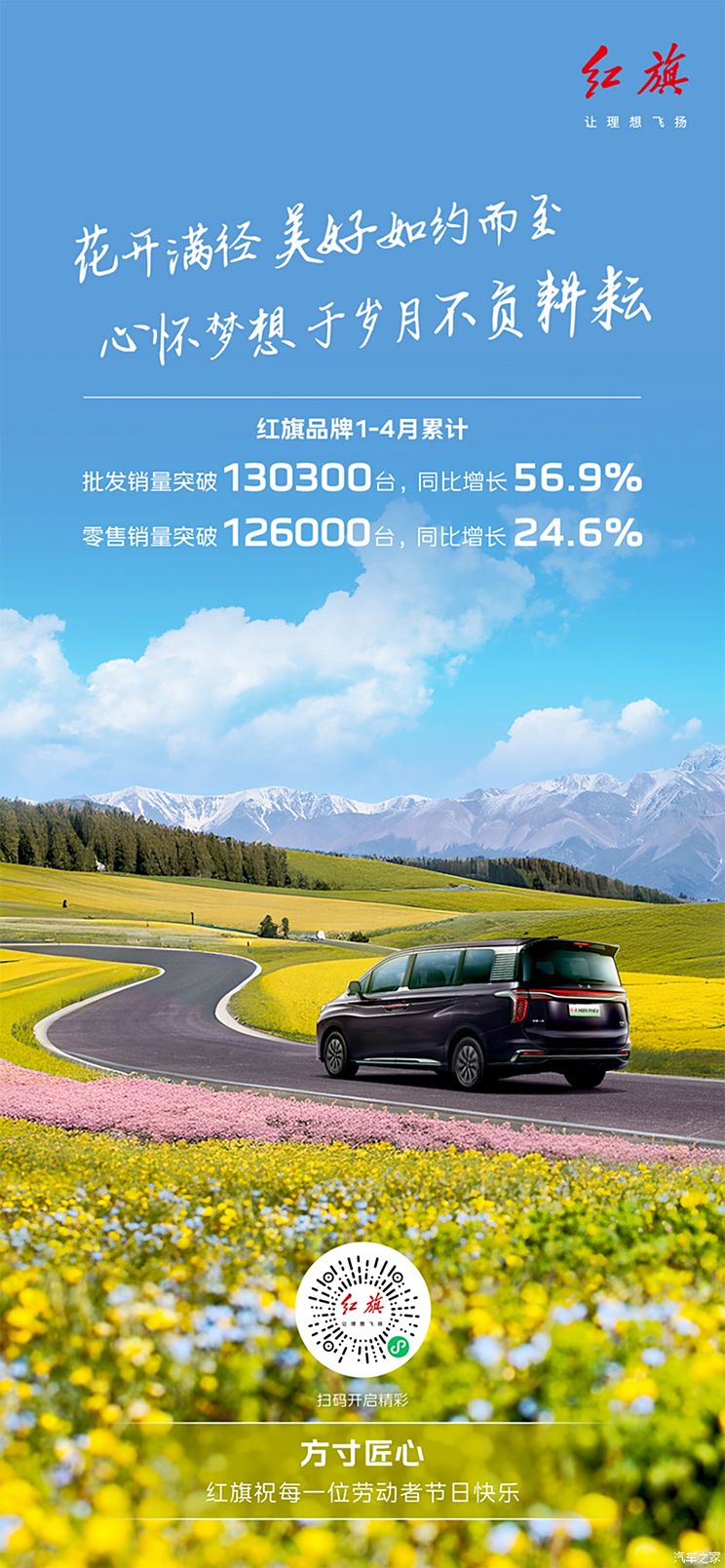
● Joint venture car companies/overseas brands:
In terms of joint venture car companies/overseas brands, there are not many companies that announce sales. FAW Toyota and GAC Toyota have basically maintained a traditional sales trend, with no ups and downs, and their sales results are not bad. SAIC-Volkswagen New Energy and SAIC-GM New Energy also achieved satisfactory sales results through price reduction.
Faw Toyota
FAW Toyota delivered a total of 56,536 new cars in April 2024, of which 7,554 were delivered by Grevia in April. In addition, FAW Toyota officially announced that all models are 100% intelligent.

Specifically, 30,206 electric vehicles were delivered, up 24% from the previous month, and the proportion increased to 53%, among which 6,647 electric cars bZ3 were delivered, up 93% from the previous month. 30,202 high-end models were delivered, an increase of 26% from the previous month and the proportion increased to 53%. In addition, FAW Toyota also launched a trade-in car purchase policy in May. The factory subsidy and the state subsidy are superimposed, and the highest subsidy can be 23,000 yuan.

FAW Toyota bZ3』
It is reported that the annual sales target of FAW Toyota this year is 880,000 vehicles. According to the previously published data, FAW Toyota sold 157,294 new cars in the first quarter, superimposed with the sales in April, and sold a total of 213,830 new cars from January to April, which has achieved 24.3% of the sales target.
Guangqi Toyota
Guangzhou Automobile Toyota sold 52,251 units in April, of which 25,598 were electrified models, accounting for 49%. There are 30,136 SUV models, accounting for 5%. The details are as follows:

The 2024 Toyota Saina SIENNA was launched on April 23rd, and nine models were launched. The suggested retail price range was 299.8-410.8 million yuan, and the price range after comprehensive discount was 284.8-395.8 million yuan (including the maximum reduction of suggested retail price of 10,000 yuan, and the official App made a decision of 15,000 yuan, which was provided by authorized dealerships in various places). As a modified model, the new car has added an E-Four four-wheel drive model, some car chips have been upgraded to Qualcomm Snapdragon 8155, and the second row of seats have also been upgraded.
○ Volvo
In April this year, the global sales volume of Volvo Cars reached 65,838, a year-on-year increase of 27%. Among them, the sales of pure electric and plug-in hybrid vehicles increased by 53% year-on-year, accounting for 48% of global sales in April. From January to April this year, the cumulative sales volume of Volvo Cars in the global market reached 214,914 vehicles, a year-on-year increase of 16%.
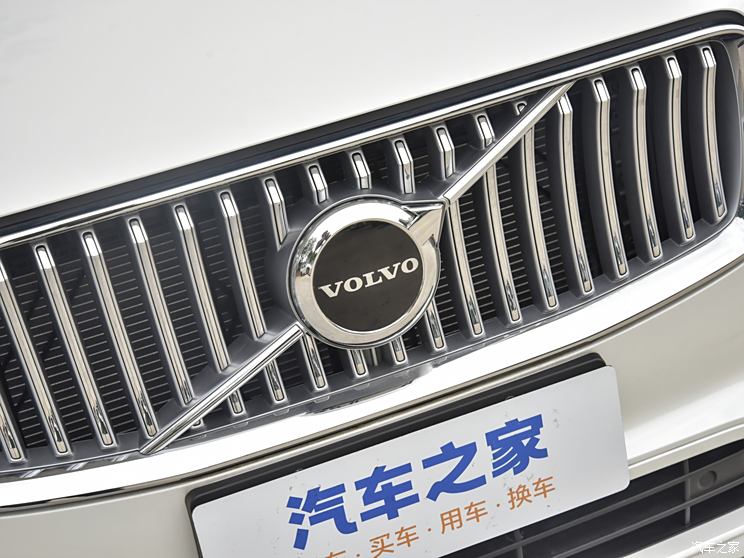
Judging from the sales situation in various markets, Volvo Cars sold 34,238 vehicles in the European market in April, a year-on-year increase of 65%. Among them, the sales of electric vehicles increased by 76% year-on-year. In the US market, Volvo Car sold 10,604 vehicles in April this year, a year-on-year increase of 10%. Among them, the sales of plug-in hybrid vehicles increased by 89%.

In China, the sales volume of Volvo Cars reached 12,221 vehicles in April, down 3% year-on-year. Among them, the sales volume of electric vehicles reached 1062, down 16% year-on-year. From the first four months of this year, the cumulative sales of Volvo Cars in China market reached 50,179 vehicles, up 2% year-on-year. In terms of vehicle sales, Volvo XC60 has become the best-selling model, with global sales reaching 19,542 vehicles. XC40 sold 15,139 vehicles in October; EX30 sold 9,730 vehicles in October.
Annwall, Chief Commercial Officer and Deputy CEO of Volvo Cars, said: With the continuous growth of delivery and electric vehicle sales, it is confident that the annual retail sales will increase by at least 15% this year.
○ SAIC Volkswagen New Energy
On the basis of the "trade-in" state subsidy of up to 10,000 yuan, SAIC Volkswagen launched the ID.Care value-added package repurchase policy. In April, the sales volume of SAIC Volkswagen brand new energy vehicles exceeded 10,000 units, a year-on-year increase of 56%. The details are as follows:

Recently, the state has proposed to stabilize traditional consumption, boost bulk consumption, and take various measures to stimulate consumption. SAIC-Volkswagen launched the outstanding "trench" ceremony for the 40th anniversary of ID.3 in March, and launched the ID.Care value-preserving package on April 20th. On April 25th, ID.4 X and ID.6 X were launched simultaneously on the media day of Beijing Auto Show.

From the beginning of the activity to June 30, regardless of the full payment or the full-scene payment of installment loans, users can purchase any model of SAIC Volkswagen ID. Family, and they can simultaneously select the ID.Care value preservation package delivered in a limited time. After owning a car for three years, you can enjoy the repurchase of 60% of the car price. The repurchase conditions only need 3 years of accumulated mileage ≤ 90,000 kilometers and 3 years of accumulated claims ≤30% of the car price. It is worth mentioning that even users who have purchased ID within three months can go back to the store to enjoy the value-added repurchase rights.
○ SAIC GM New Energy
SAIC-GM delivered 8,762 new energy vehicles in April, a year-on-year increase of 93.1%. The details are as follows:
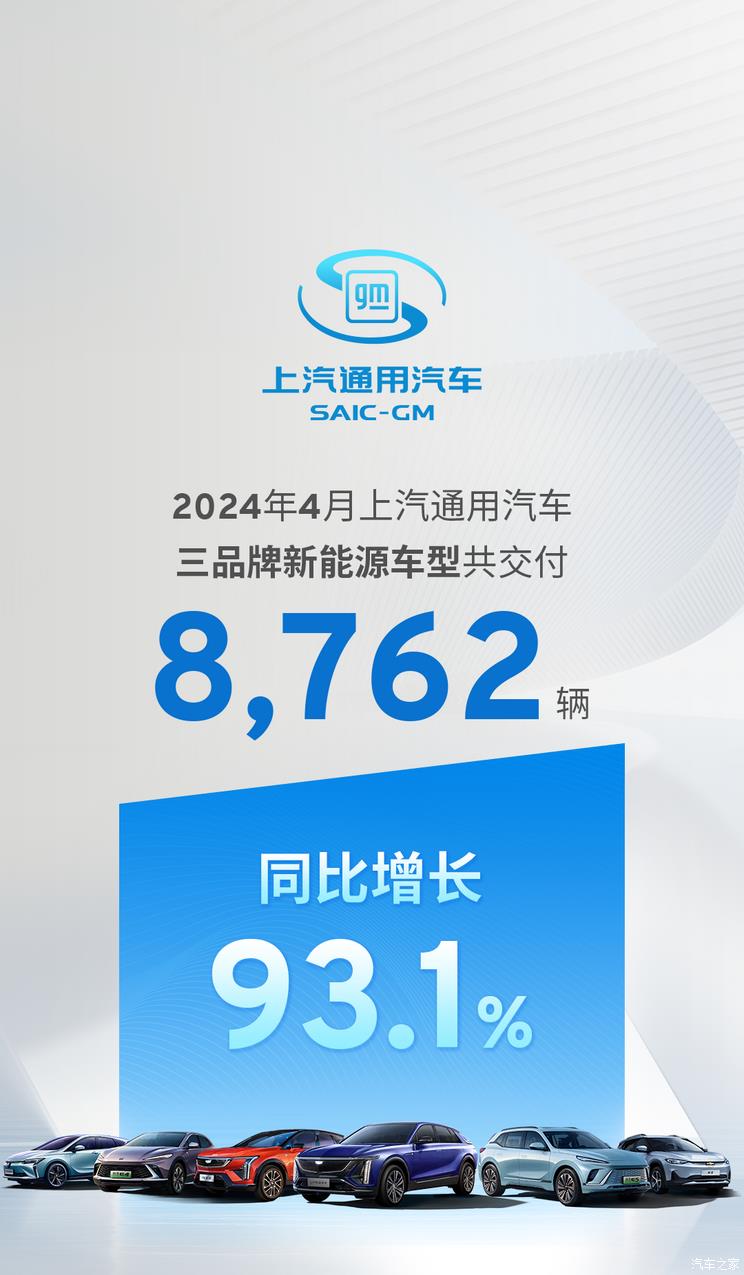
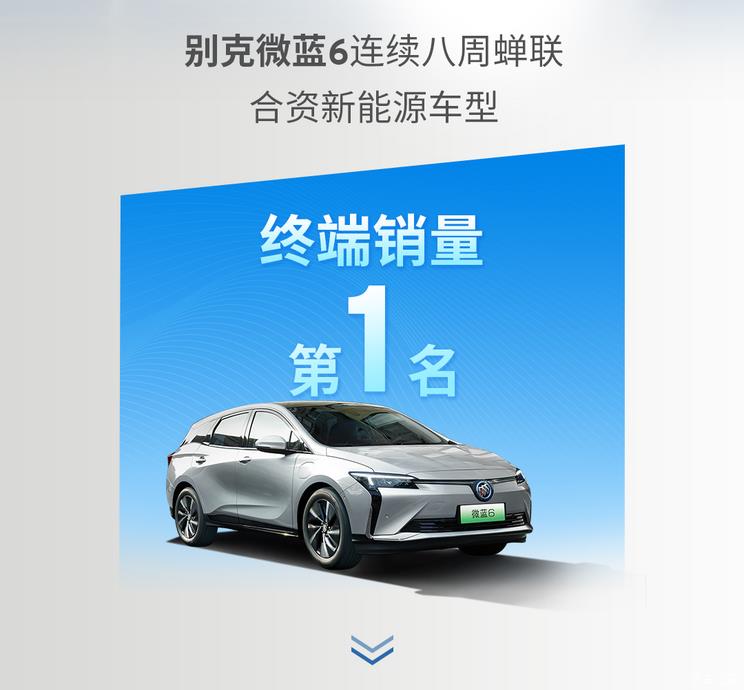
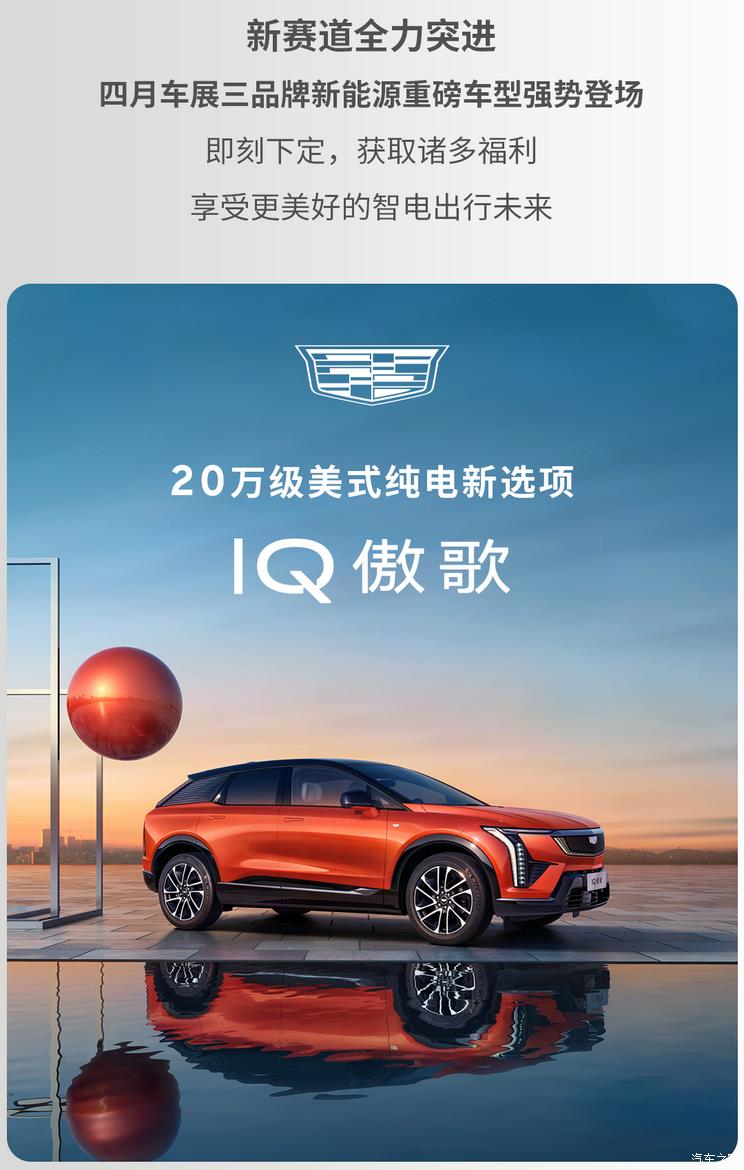
At the 2024 Beijing Auto Show, Cadillac IQ Aoge ushered in the official listing. The new car launched two models, the four-wheel drive long battery life version and the standard battery life version, with a price range of 23.97-26.97 million yuan. As the second electric SUV of Autoenergy platform after Cadillac’s IQ sharp song, the new car as a whole continues to be built in family-style design language and has a good performance.

Previously, Buick GL8 Luzun PHEV was officially listed, and three models were launched, with a price of 359,900-419,900 yuan. The new car will be equipped with SAIC-GM’s new generation PHEV intelligent plug-in and hybrid system. CLTC has a pure battery life of 138km and a comprehensive battery life of 1370 km. In the future, Buick plans to launch a pure electric version of the GL8 model after inserting the mixed version of the GL8.
● New forces for building cars:
The new force of making cars is the core of the sales announced by car companies every month. Tesla continues to lead with 62,167 cars. Of course, it also contains export data. Compared with other car companies, Tesla often adjusts its production capacity according to different market demands around the world. Huawei’s HarmonyOS Zhixing continues to be far ahead, including two series, namely AITO’s Intellectual Community and Intellectual Community. Among them, Intellectual Community sold 25,086 units in April, up 417% year-on-year, and Intellectual Community sold 4,546 units in April. However, compared with the hot delivery of the new M7 in March, there was a big drop in April, but on the contrary, the sales of M9 () in the world rose. Ai ‘an and Ideality also rank in the first echelon of new forces, but the sales volume of Ai ‘an has dropped sharply year-on-year, which is rare among new energy vehicle companies. LI has not completely walked out of the haze in April, and its sales growth is weak, but it is expected that it will perform well after delivery in May.
In the second echelon, there are mainly brands with sales of more than 10,000 units, including Extreme Krypton, Weilai, Zero Run, Deep Blue, Geely Galaxy, Chang ‘an Qiyuan, Tengshi, etc., among which Extreme Krypton, Weilai and Zero Run all achieved substantial year-on-year growth. The third echelon is mainly brands with less than 10,000 sets, including Tucki, Nezha, Xiaomi, Aouita, Euler, Lantu, Equation Leopard, Wangwang, etc. Among them, Aouita’s growth rate is also quite obvious, and the sales volume has been improved through price reduction. After the subsequent increase in production capacity, Xiaomi Automobile will probably become a dark horse and impact the first few echelons.
Tesla.
According to the data of the Federation, Tesla Giga Shanghai is expected to deliver a total of 62,167 electric vehicles in April 2024. In 2023, Model Y became the best-selling passenger car in the world with sales of more than 1.2 million vehicles. Continuing the sales momentum, Tesla has recently sold more than 10,000 vehicles in the China market for several weeks.

HarmonyOS Zhixing.
HarmonyOS Zhixing Company delivered 29,632 vehicles in April. Specifically, 13,391 vehicles were delivered by the asking sector M9, 10,896 vehicles by the asking sector M7 and 4,546 vehicles by the intellectual sector S7.
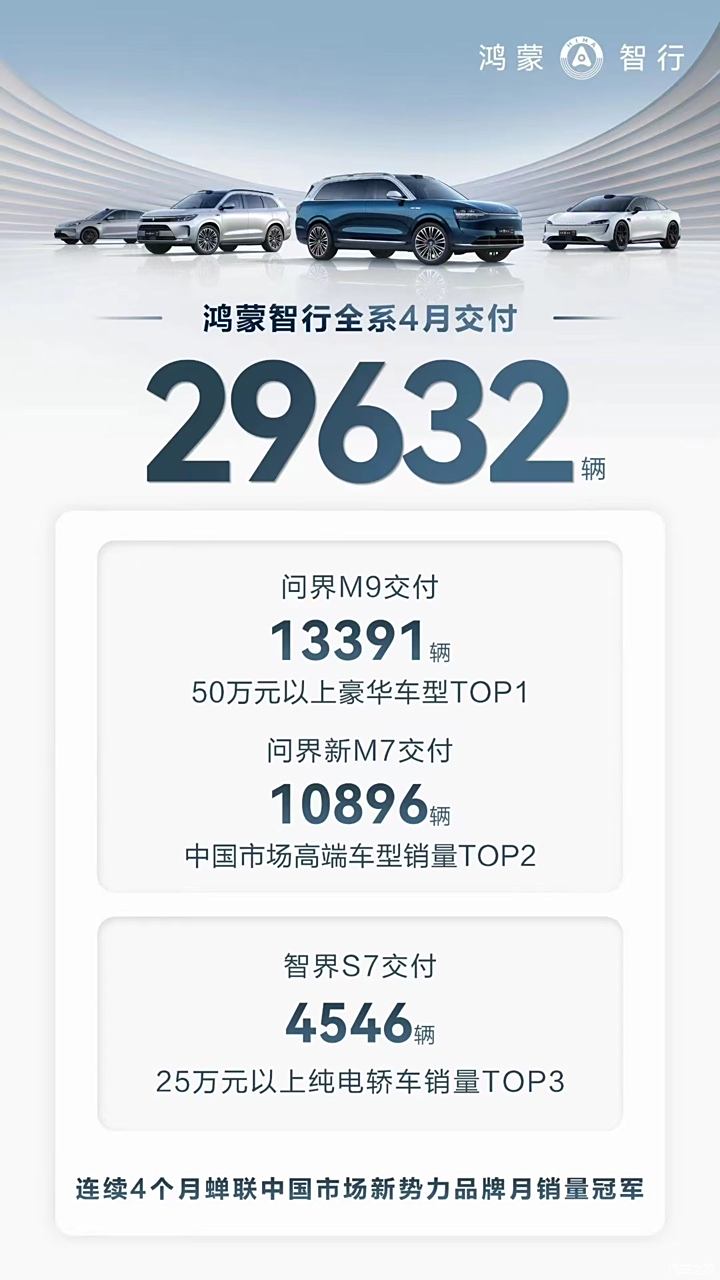

Wenjie M9 locates the flagship large SUV, and the price range is 469.8-569.8 million yuan. In terms of power, the M9 will provide two sets of power systems, the extended range version and the pure electric version, and both adopt the layout of front and rear double motors. Among them, the maximum power of the front motor and the maximum power of the rear motor of the pure electric version is 160kW and 230kW, and it is equipped with a ternary lithium battery with a capacity of 97.682kWh provided by Contemporary Amperex Technology Co., Limited, and its pure electric cruising range is 630km under CLTC conditions.
The extended range version uses H15RT 1.5T engine, with a thermal efficiency of 41% and a maximum power of 112kW. It is matched with double motors, and the maximum power is 165kW and 200kW respectively. The battery is a ternary lithium battery from Contemporary Amperex Technology Co., Limited, which comes standard with a 42-degree battery. Under CLTC conditions, the comprehensive battery life reaches 1362km and the pure battery life is 225km;. A 52-degree battery version CLTC is also available, with a comprehensive battery life of 1402km and a pure battery life of 275km, and the optional price is 20,000 yuan.
It is worth mentioning that the M9 pure electric version of Wenjie is equipped with 800V high-voltage silicon carbide platform, which can last 150km for 5 minutes. The extended range version is equipped with pure electric drive extended range platform 4.0, which brings 4.3 seconds and 4.9 seconds of 0-100km/h acceleration respectively. In addition, it is equipped with a 4-piston fixed caliper high-performance braking system, and can be equipped with 22-inch double ten-spoke moving wheels or 21-inch low wind resistance wheels. The braking distance at 100-0km/h is only 34.9 meters.

The M7 is positioned as a medium and large SUV, and the price range is 249.8-329.8 million yuan. In terms of power, the new model M7 adopts HUAWEI DriveONE extended-range electric drive platform, equipped with a 1.5T extended-range hybrid system, and provides a rear-drive version and a four-wheel drive version. The maximum power of the rear drive version is 272 HP, and the comprehensive maximum power of the four-wheel drive version is 449 HP. The four-wheel drive version of CLTC has a pure electric cruising range of 210km, and the rear-drive version is 240km.

Zhijie S7 locates medium and large cars, and the price range is 24.98-34.98 million yuan. In terms of power, Zhijie S7 comes standard with HUAWEI DriveONE 800V high-voltage silicon carbide platform, which can recharge 215km in 5 minutes and 430km in 15 minutes. The two-wheel drive version has a maximum power of 292 HP, and the four-wheel drive version has a maximum power of 496 HP. Its 0-100km/h acceleration time is 3.3 seconds, the braking distance of 100-0km/h is only 33.5 meters, and the comprehensive endurance of CLTC can reach up to 855km. In addition, the new car is equipped with Turing intelligent chassis, CDC variable damping shock absorber and air suspension to improve handling stability.
○ Ian
Guangzhou Automobile Aian sold 28,113 vehicles worldwide in April. At the same time, the official said that AION V and 2024 Haobo HT have arrived in the store one after another, and you can enter the store for details.
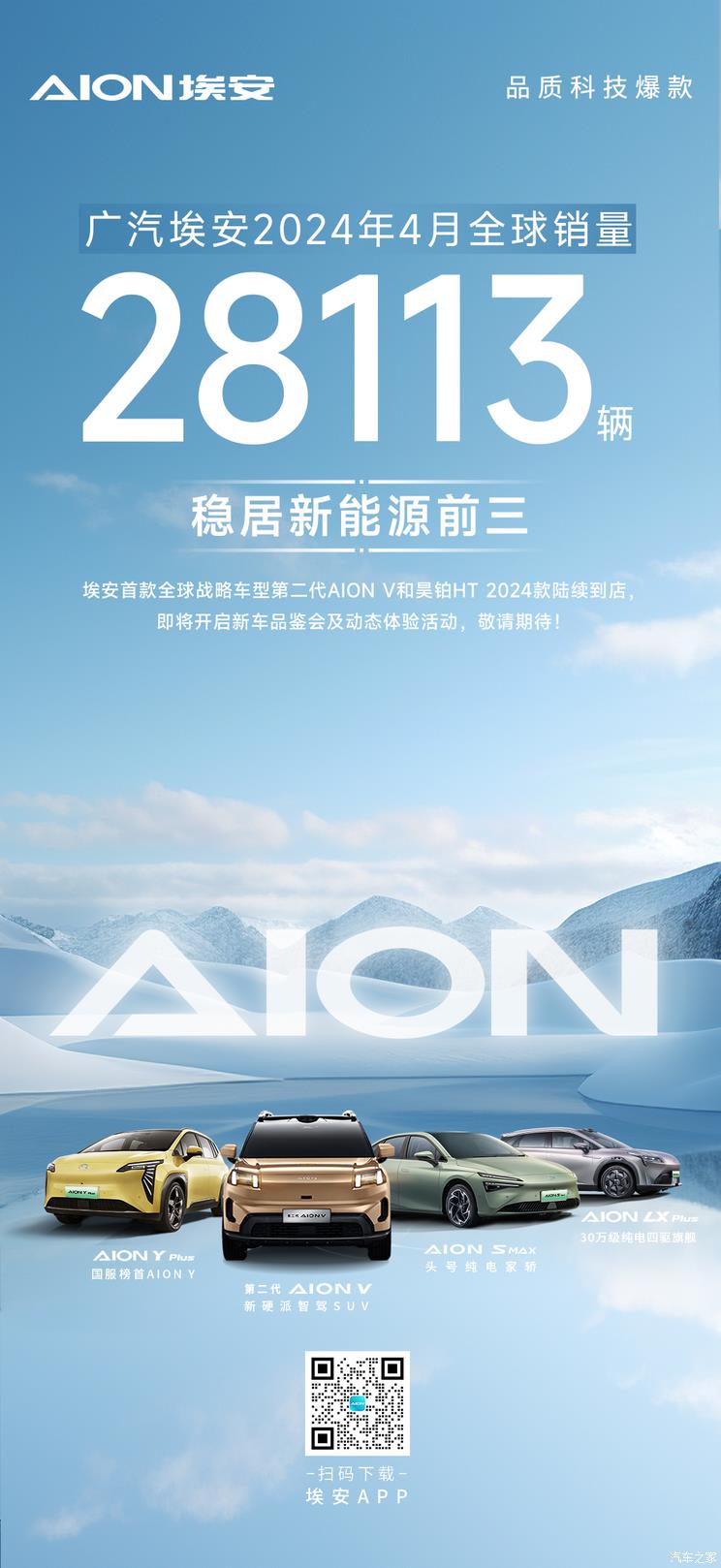


At the 2024 Beijing Auto Show, GAC Aian brought a brand-new pure electric SUV-the second generation AION V, which was built on the AEP pure electric platform, adopted a brand-new design concept, and focused on intelligent driving. The new car has a length of 4605mm and a wheelbase of 2775mm. In terms of battery life, AION V has reached 750km, equipped with self-developed second-generation ITS2.0 intelligent temperature control system, charging 370 km in 15 minutes.
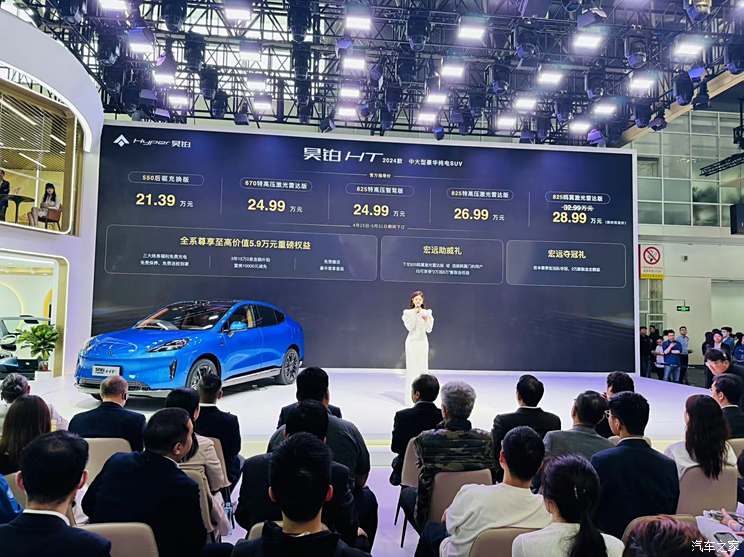

Also at the Beijing Auto Show, the new Hao Platinum HT was officially launched.A total of five models were launched.The price range is 21.39-32.99 million yuan.. In terms of limited-time rights and interests, users who set up the 825 Eurowing Lidar version or install gull-wing doors can enjoy the rights and interests of 20,000 to 60,000 expansion funds. If Hongyuan team wins the championship this season, 20,000 yuan expansion funds will be returned.
| Guide price of 2024 Haobo HT |
| car make and model |
Price (ten thousand yuan) |
| 550 rear drive charging and changing plate |
21.39 |
| 670 UHV Lidar Edition |
24.99 |
| 825 UHV Intelligent Driving Edition |
24.99 |
| 825 UHV Lidar Edition |
26.99 |
| 825 Eurowing Lidar Edition |
32.99 |
In terms of power, the new car adopts 800V technology, charging 425km in 15 minutes, and the cruising range includes 550km, 670km and 825km. The total power of the motor is 180 kW and 250 kW respectively, and the total torque is 355 Nm and 430 Nm. In terms of intelligent driving, the new car will be equipped with lidar, and the 2024 model will be the first to have urban NOA function, which will be available nationwide in September.
LI.
In April, LI delivered 25,787 new cars, up 0.4% year-on-year. By April 30, 2024, LI had delivered a total of 739,551 vehicles.
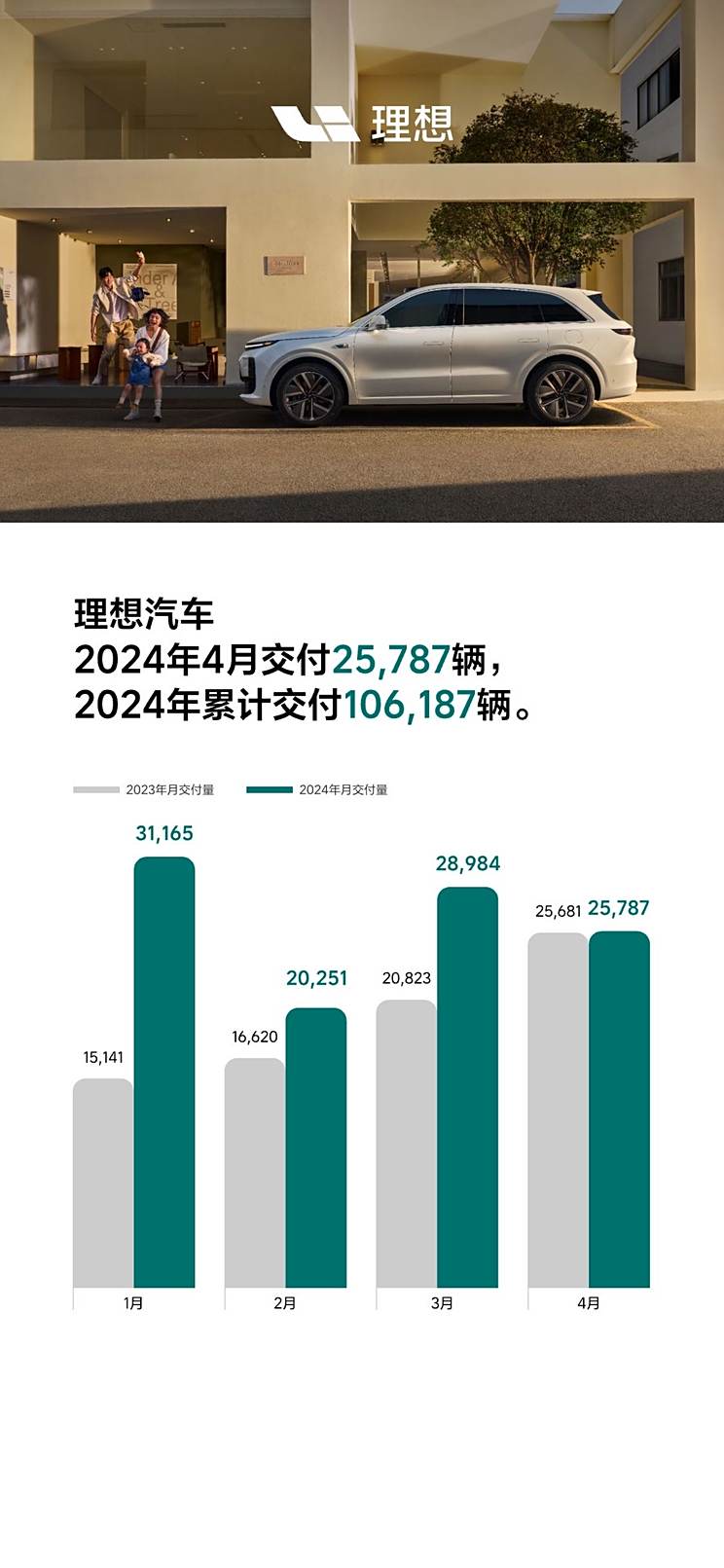

On April 18th, Ideal L6 was officially launched, and two models were launched, with a price of 249,800-279,800 yuan. The new car is a five-seat medium and large extended-range SUV, which is positioned under the ideal L7.
On April 24th, the delivery of Ideal L6 was officially started, and the delivery centers in 68 cities across China, including Beijing, Zhejiang, Shandong, Jiangsu and Guangzhou, welcomed the first owners of Ideal L6 at the same time. The official said that the ideal L6 will start mass delivery in May. The first batch of users who order the ideal L6 before May 5 can enjoy three rights and interests with a total value of 20,000 yuan, including an optional fund with a value of 10,000 yuan, which can be used to select special edition car paint colors and 21-inch rims; Household charging piles and installation services worth 5,000 yuan; The deposit of 5,000 yuan is directly deducted from 10,000 yuan.
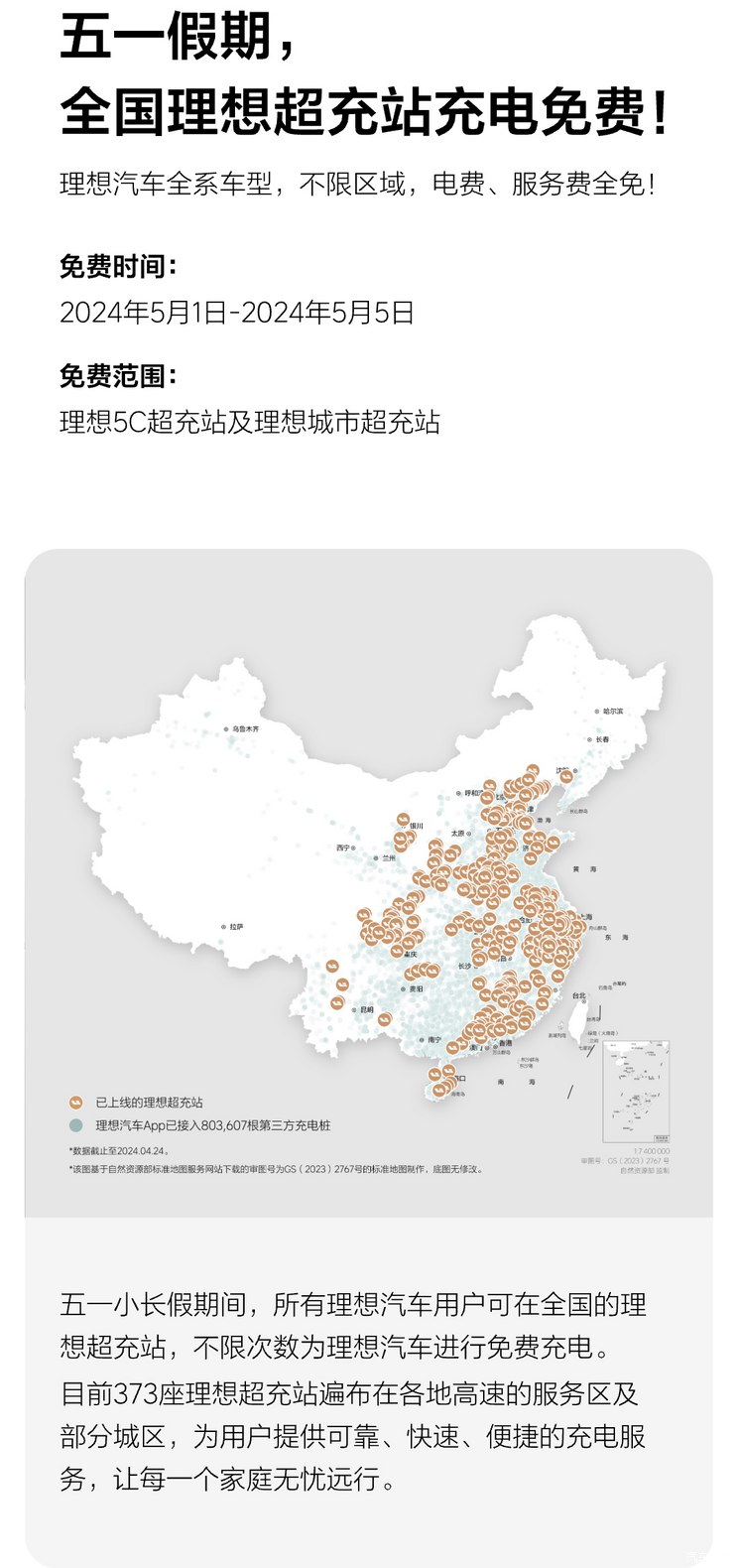
It is worth noting that during the May Day holiday, LI Delivery Center delivered the goods normally, and all models in LI were charged at the ideal overcharge station for free.
In addition, OTA version 5.2 will also be pushed in May, and the platform capabilities of intelligent driving AD Pro and AD Max will be fully evolved, and the functions of intelligent driving, intelligent parking and active safety will be more mature and safe. The upgraded vehicle will also support Siri car control, and voice operation will be more convenient and faster.
By April 30, 2024, LI had 481 retail centers nationwide, covering 144 cities; There are 361 after-sales maintenance centers and authorized car body panel spraying centers, covering 210 cities. LI has put into use 386 ideal overcharge stations in China, with 1,678 charging piles.
Extreme krypton
Krypton delivered 16,089 units in April, up 99% year-on-year and 24% quarter-on-quarter, and up 111% year-on-year from January to April, reaching a record high. The details are as follows:
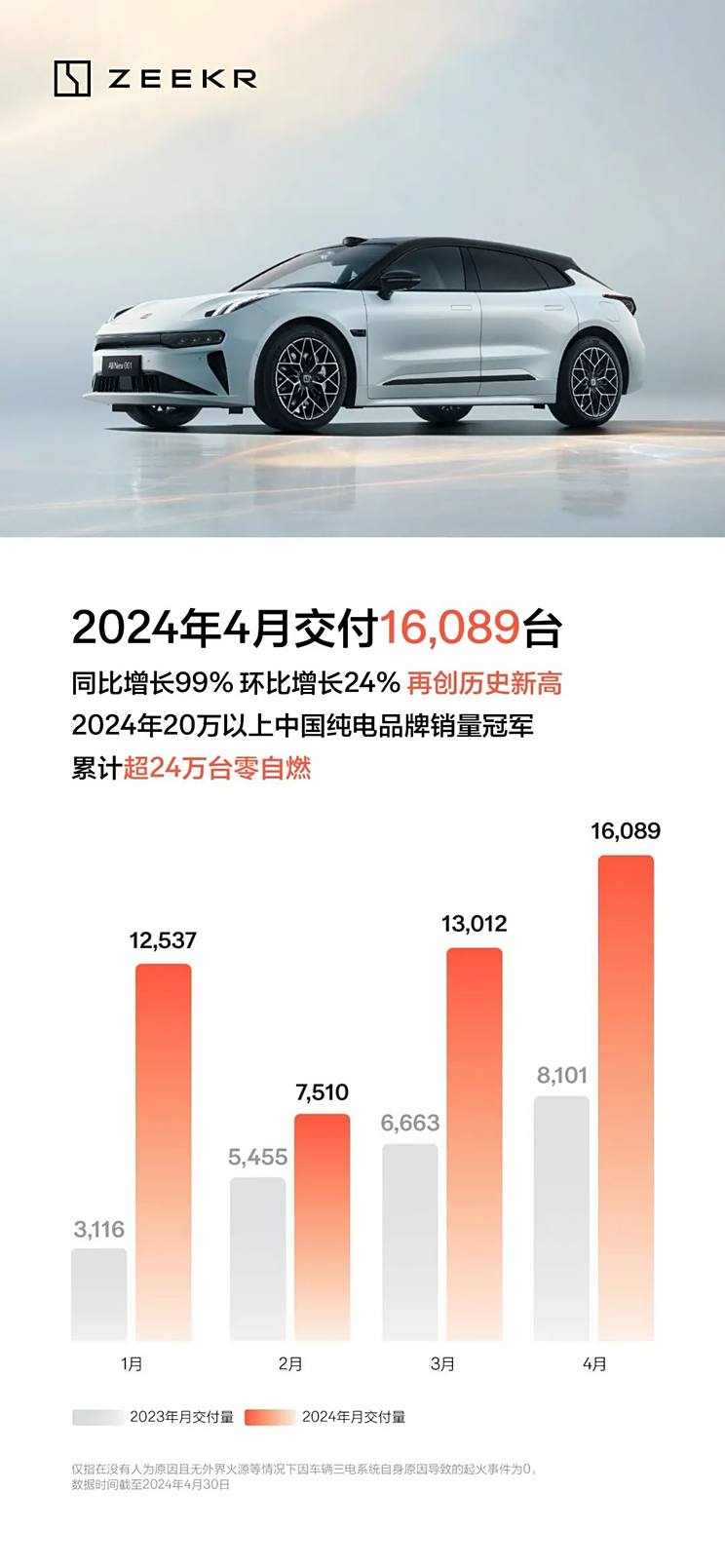
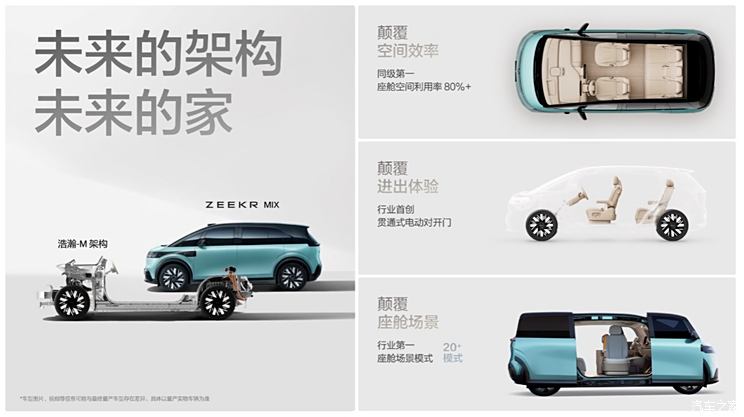
The MIX was unveiled at the Beijing Auto Show and will be launched in the second half of this year. As the fifth model of MIX, the car is built on the vast -M architecture, which continues the latest design language of MIX, equipped with STARGATE integrated intelligent light screen and adopts a new way to open the door.
Wei lai
In April 2024, Weilai delivered 15,620 new cars, up 134.6% year-on-year and 31.6% quarter-on-quarter. Up to now, Weilai has delivered a total of 495,267 new cars.
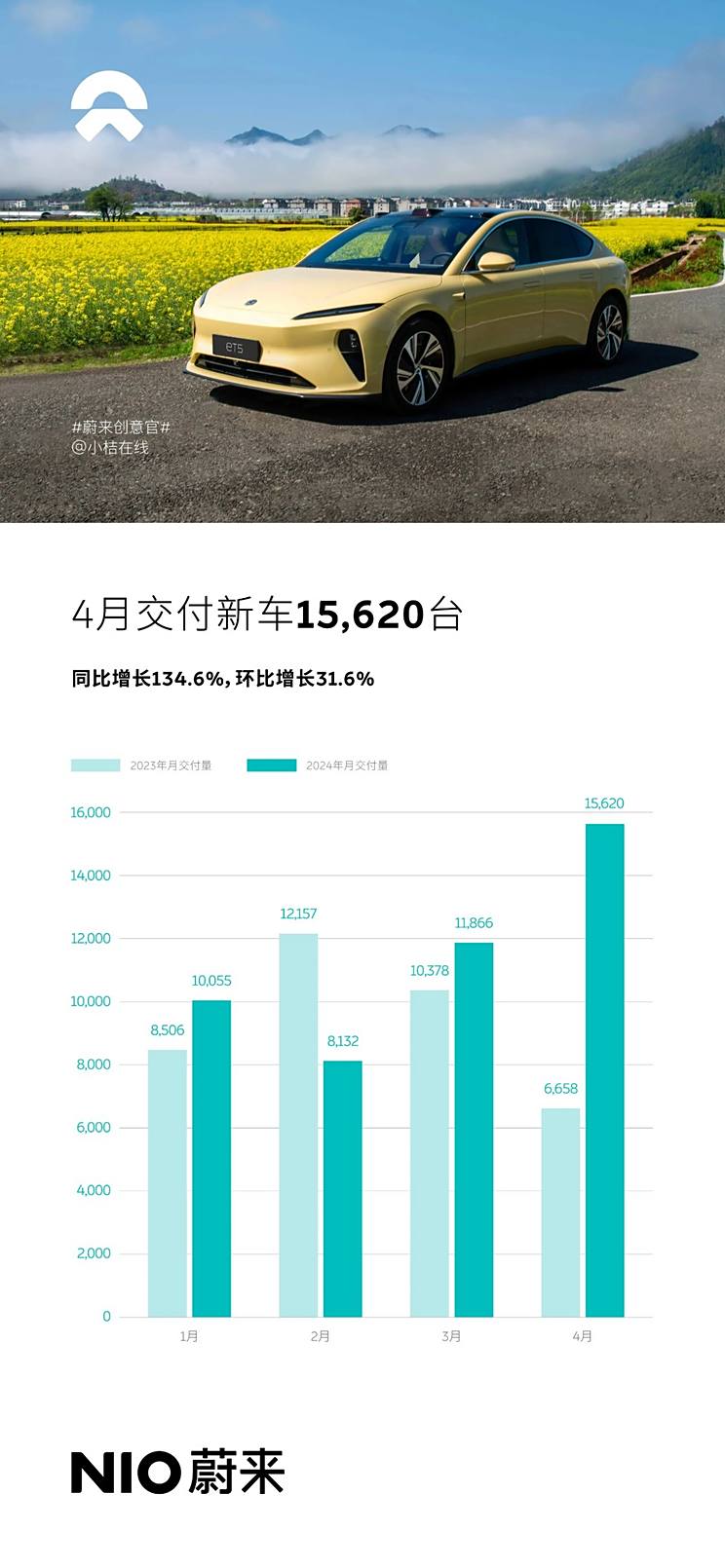
It is worth noting that Weilai launched a "0 down payment" car purchase scheme in May, and "trade-in" can enjoy an exclusive subsidy of up to 20,000 yuan. In addition, in May, Weilai will welcome the 500,000 th production car off the assembly line.
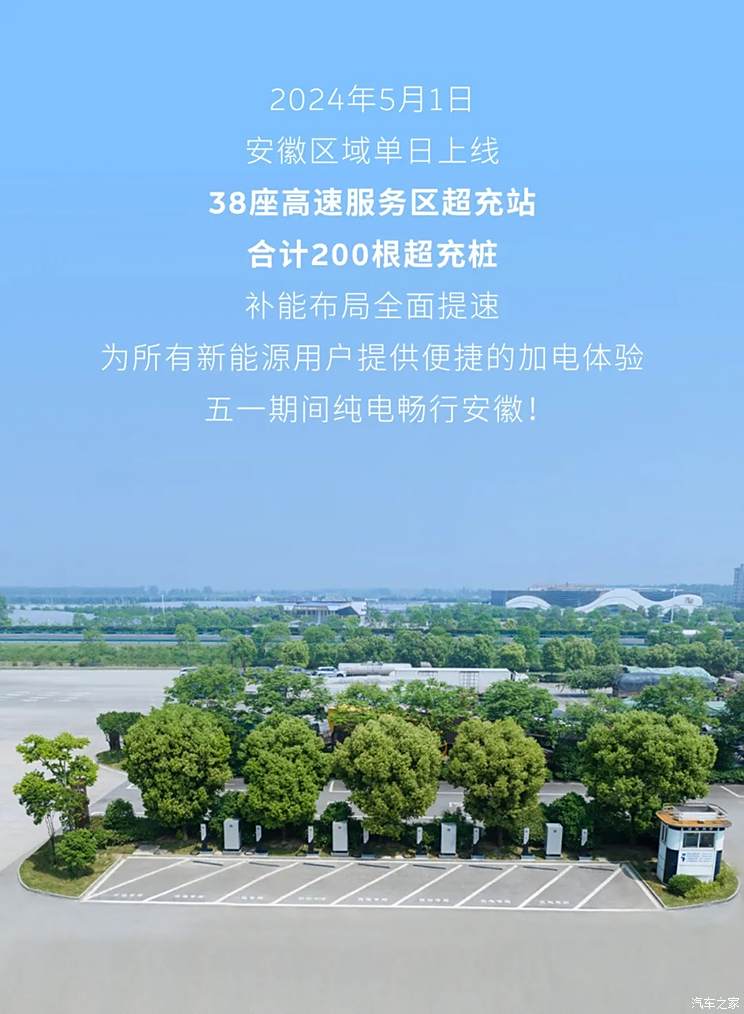
On May 1st, Weilai launched 38 overcharged stations and 200 overcharged piles in Anhui in a single day, and the high-speed charging and replacing network in Anhui province has been opened. As of May 1st, there are 51 high-speed power exchange stations, 42 high-speed overcharging stations and 221 overcharging piles in the expressway service area of Anhui Province.
Zero run
In April 2024, 15,005 zero-run cars were delivered, and the delivery of two SUV models C11 and C10 exceeded 10,000. The details are as follows:
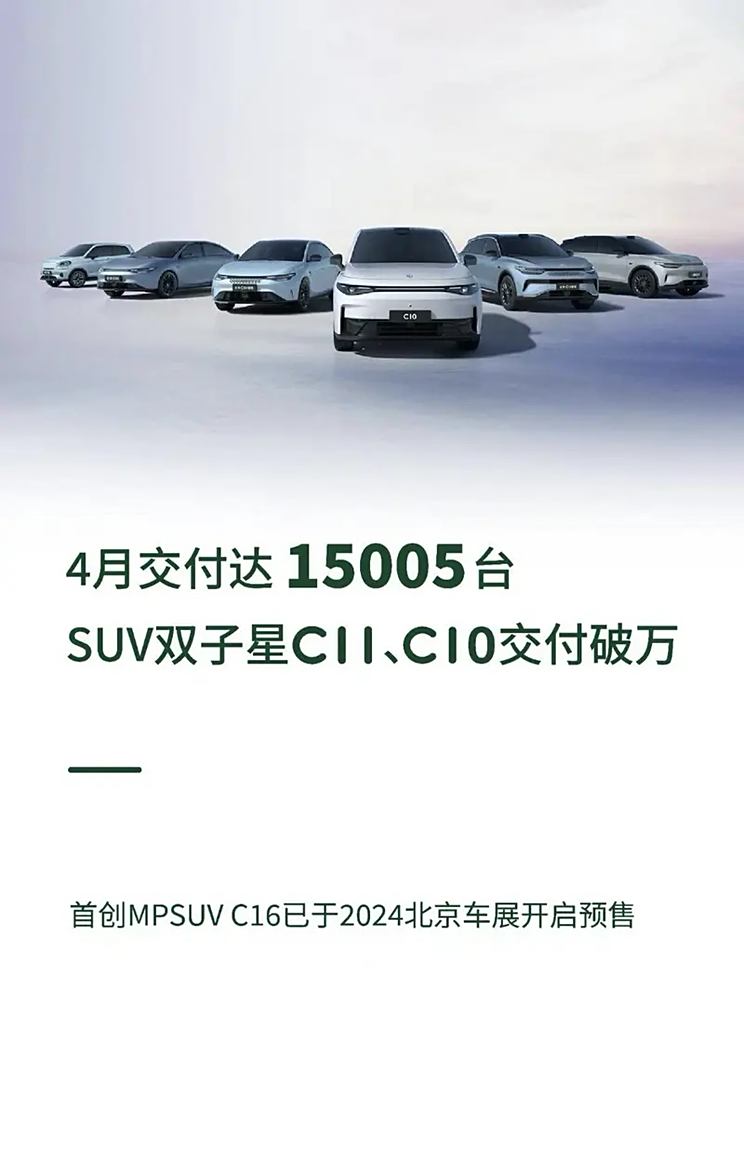
At the 2024 Beijing Auto Show, the Zero Run C16 officially made its debut. The new car is positioned as a medium-sized SUV, which is positioned higher than the Zero Run C10. It will be the first zero run vehicle with 800V fast charging, and it will be listed and delivered in June 2024. C16 opened the reservation at this Beijing Auto Show, and within 24 hours, the order volume exceeded 11,950 units.
Tucki.
In April 2024, Xpeng Motors delivered 9,393 new cars, up 33% year-on-year and 4% quarter-on-quarter. Among them, Tucki X9 delivered 1,959 units, and nearly 10,000 units were delivered in four months after listing. From January to April, 2024, Xpeng Motors delivered a total of 31,214 units, a year-on-year increase of 23%.
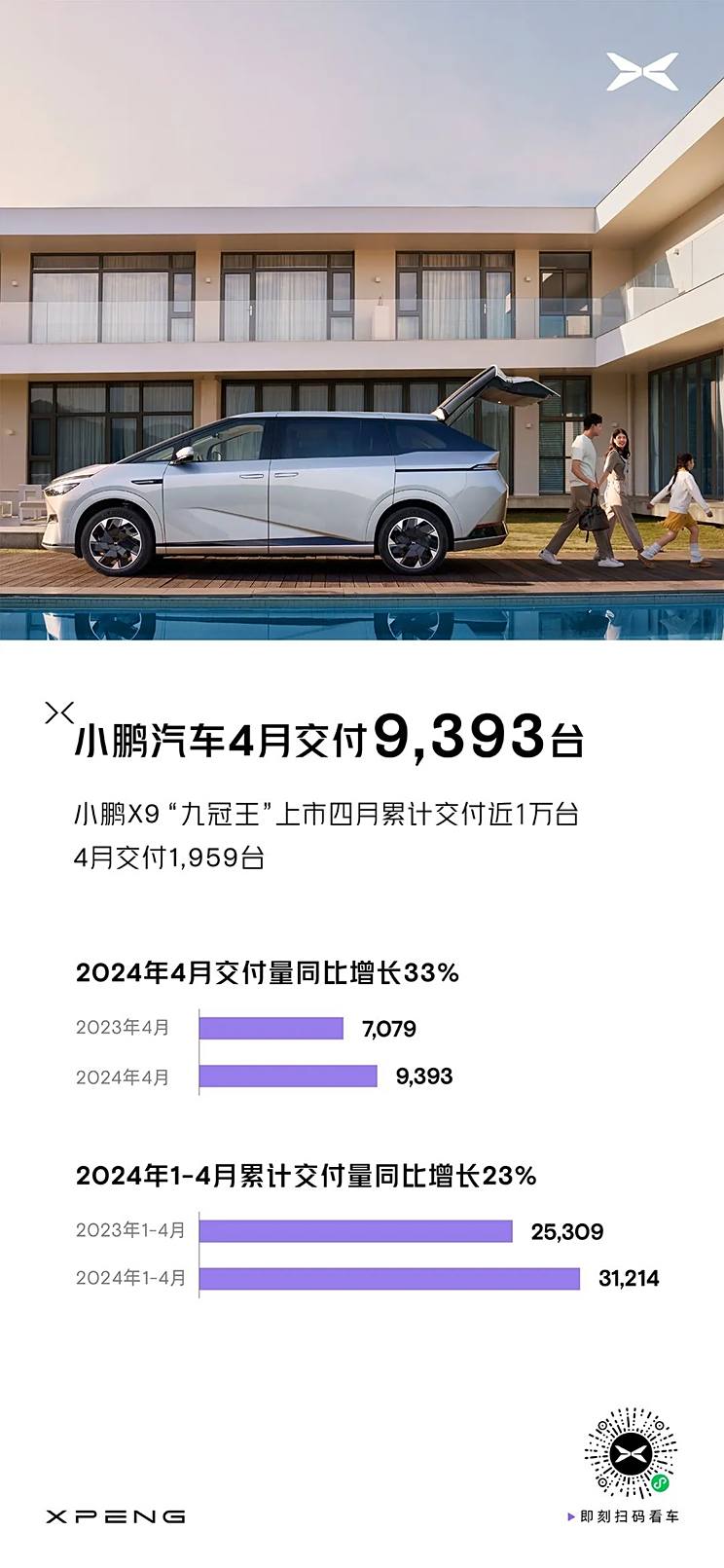
In April, the penetration rate of monthly active users of XNGP City Zhijia reached 82%. As of April 24, 2024, XNGP has fully covered 260 cities across the country, and the scope of Kaesong continues to expand. In April, Xpeng Motors successfully completed the high-speed NGP road test in Germany. On April 9th, Xpeng Motors announced its formal entry into the Hong Kong and Macao markets, bringing Xpeng Motors’s G9, X9, G6 and P7i models to consumers in Hong Kong and Macao.
On April 17th, Xpeng Motors and audi ag signed a strategic cooperation framework agreement on electronic and electrical architecture technology. Based on the latest generation of electronic and electrical architecture in Xpeng Motors, the two parties will jointly develop and integrate it into Volkswagen’s CMP platform in China, which is expected to be applied to Volkswagen brand electric vehicles produced in China from 2026. At the auto china on April 25th, He Xiaopeng, Chairman and CEO of Xpeng Motors, announced the world premiere of AI Tianji system, which will be fully launched on May 20th, and the brand-new MONA will officially meet with consumers in June.
Nezha.
Nezha Auto delivered 9,017 vehicles in April. Meanwhile, on April 22nd, Nezha L completed its listing, and started mass delivery in May. At present, the order has exceeded 15,000 units.
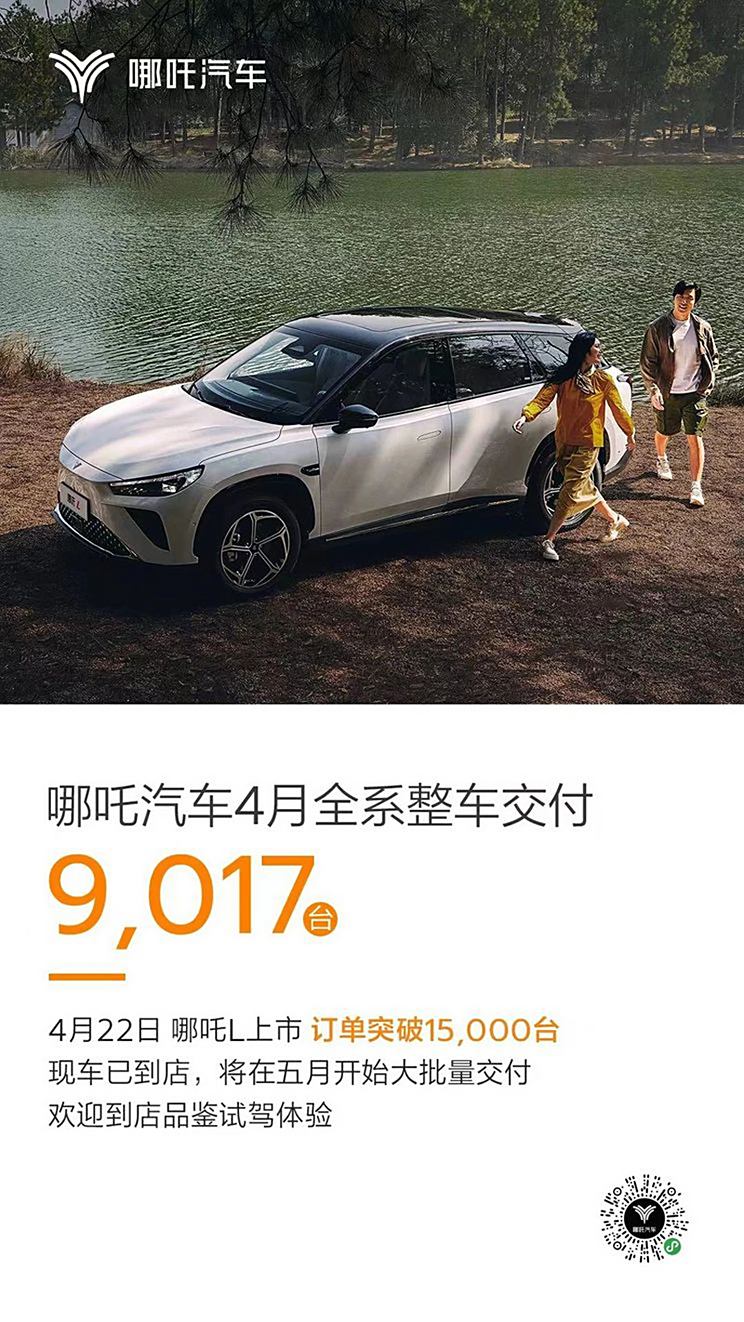
As a review, Nezha L has launched four versions with the price range of 129,900-159,900 yuan. The Nezha L extended-range version will be equipped with a 1.5L four-cylinder extended-range system, with a compression ratio of 14.9:1, a thermal efficiency of 40%, and a maximum power generation of more than 60kW, so it can use No.92 gasoline. The maximum power of the driving motor is 170kW and the peak torque is 310 N m.. The Nezha L Extended Range Model will use the Ferrous lithium phosphate flash charging core from Contemporary Amperex Technology Co., Limited, and the charging rate can reach 2.6C, which makes the charging time from 30% to 80% 19 minutes.
Depending on the configuration, the battery pack capacity of the new car is 30kWh or 40kWh, which can provide CLTC pure battery life of 220km or 310km. The 0-100km/h acceleration time of 220 flash charging model is 7.3 seconds, and the fuel consumption is 4.85 L/100 km. Three models of 310 flash charging version, the acceleration time of 0-100km/h is 8.2 seconds, and the fuel consumption is 5L/100km.
○ Xiaomi automobile
Xiaomi SU7 delivered 7,058 units in April. At the same time, the cumulative number of lock orders has reached 88,063. It is reported that Lei Jun said on his personal social media that Xiaomi Automobile is making every effort to expand production capacity and speed up delivery to ensure the completion of the task of delivering 100,000 units this year. The details are as follows:



It is reported that in 2024, Xiaomi SU7 will accelerate in delivery, service and OTA. The standard version and Pro version originally planned to be delivered at the end of April have been advanced to April 18th, and the Pro version will be delivered at the end of May, and the delivery is expected to exceed 10,000 units in June. In addition, Xiaomi Automobile plans to carry out the first OTA after the new car is released in May, such as online wireless CarPlay function, end-to-end parking service and other intelligent driving experiences. The second OTA will be held at the end of May, and version 1.2 will officially release the NOA function of cities, taking the lead in opening 10 cities including Beijing, Shanghai, Guangzhou, Shenzhen, Hangzhou, Suzhou, Nanjing, Chengdu, Xi ‘an and Wuhan, and will be opened nationwide in August.
Aouita.
In April, 2024, Aouita delivered a total of 5,247 vehicles, a year-on-year increase of 226%. Aouita App will fully access Huawei’s liquid-cooled super-charging piles covering the whole country, providing one-stop charging service. In the future, Aouita models will be equipped with Gankun ADS 3.0 and a new generation of HarmonyOS cockpit, which will bring users a better intelligent experience.
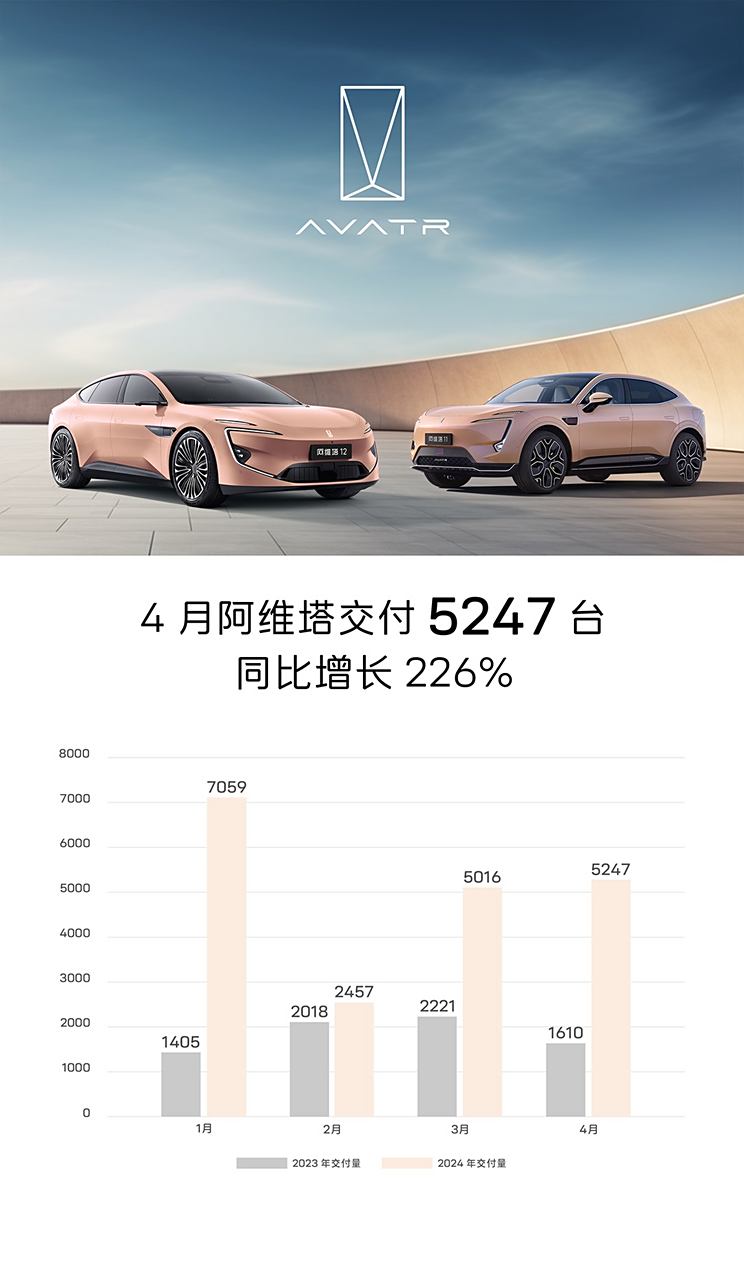
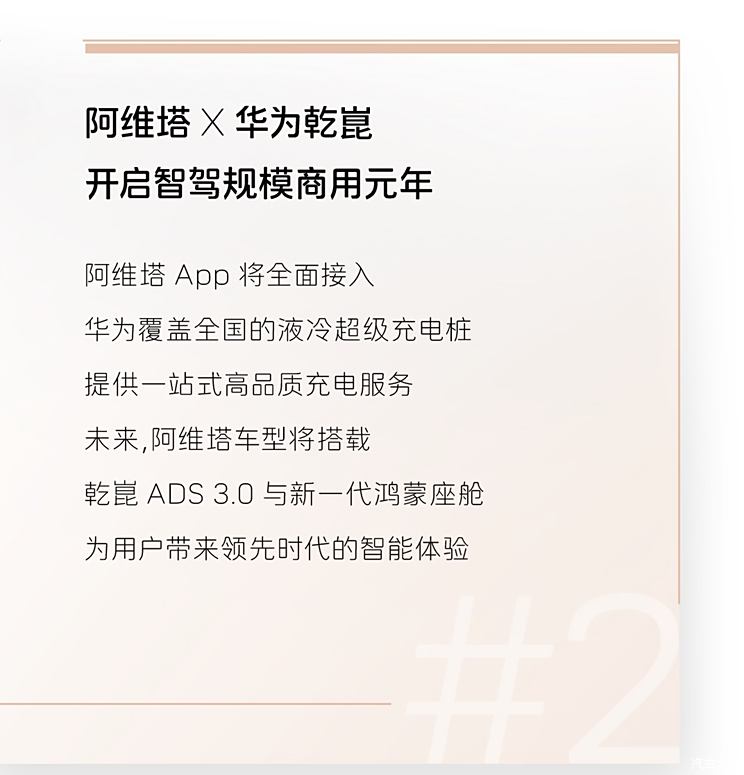

"Aouita 15"
Earlier, Yong Jun, vice president of Aouita Science and Technology, revealed that Aouita 15 and 16 will be released in the second half of the year, and Aouita 11 and 12 will launch extended-range models. Aouita 15 is an SUV, compared with Tesla Model Y, and Aouita 16 is a medium-sized coupe, compared with Tesla Model 3. Aouita 15 and 16 will be smaller and cheaper than 11 and 12. Aouita’s official account has previously revealed that in 2024, Aouita will launch four extended-range models, which should be Aouita 11, 12, 15 and 16, and there will also be pure electric models in 15 and 16.

"Aouita 15"

"Aouita 15"
According to the latest spy photos, the design style of Aouita 15 is similar to that of Aouita 11, but its compartment doesn’t seem to adopt the spatial layout of separating the passenger compartment from the trunk like Aouita 11. For a smaller SUV, although it lacks a personality, it is more practical. The front of the car is expected to adopt a family-style design similar to Aouita 11, while the rear of the car is expected to adopt a new style.
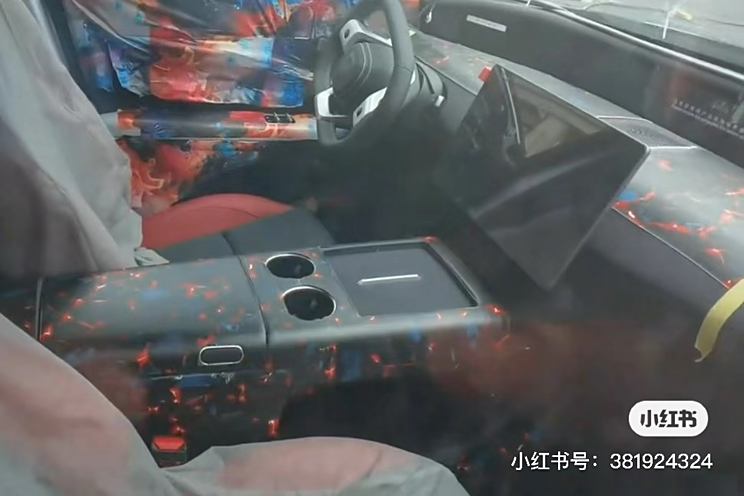
"Aouita 15"
It can be seen that the body design of the new car is full, the waistline is quite dynamic, and the roof is equipped with a panoramic canopy. The size of the rear window is not small, the view is obviously better than that of Aouita 11, and the size of the whole tailgate is not small. The interior of the new car is in line with Aouita 12, including a penetrating instrument panel and a suspended central control panel.
○ Lantiu
In April 2024, Lantu Automobile delivered 4,003 vehicles, a year-on-year increase of 20%. From January to April, the cumulative sales volume reached 20,348 vehicles, a year-on-year increase of 126%.
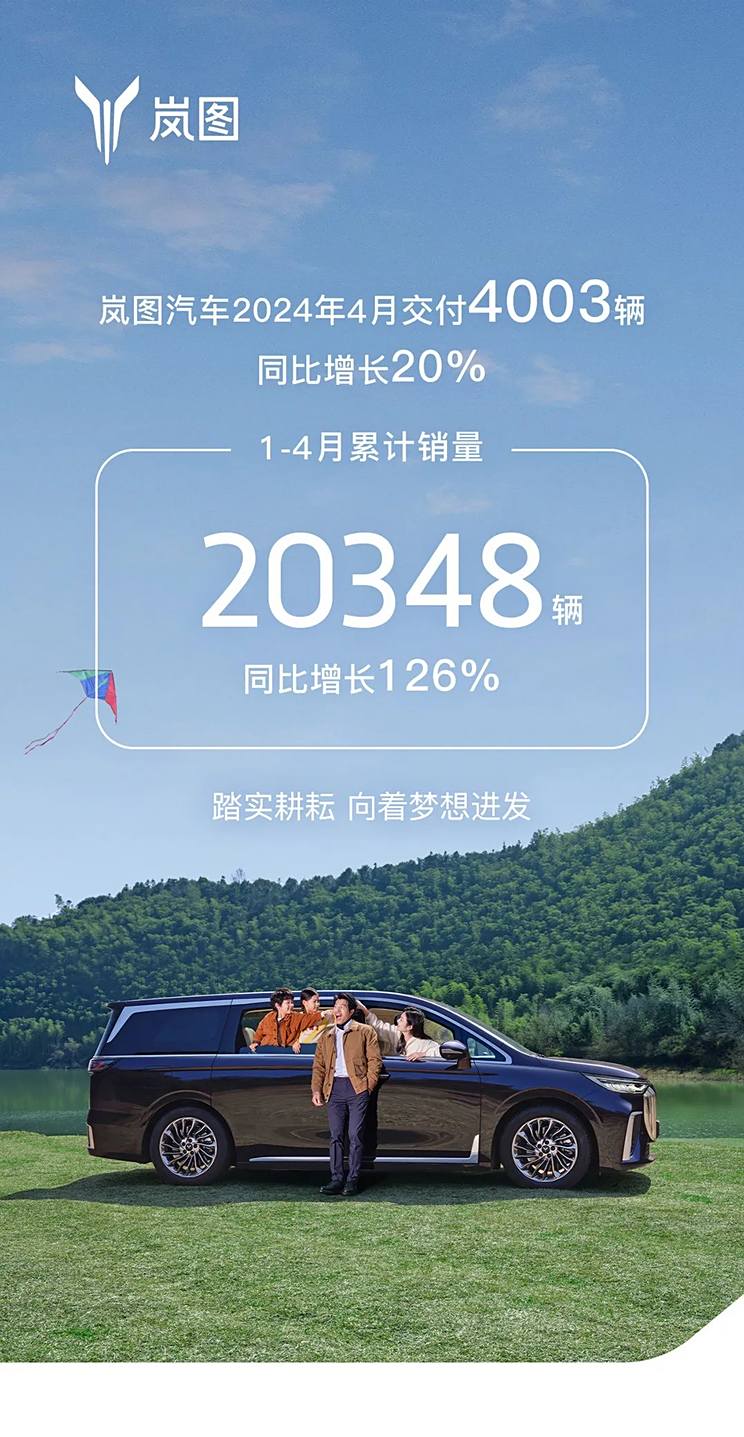
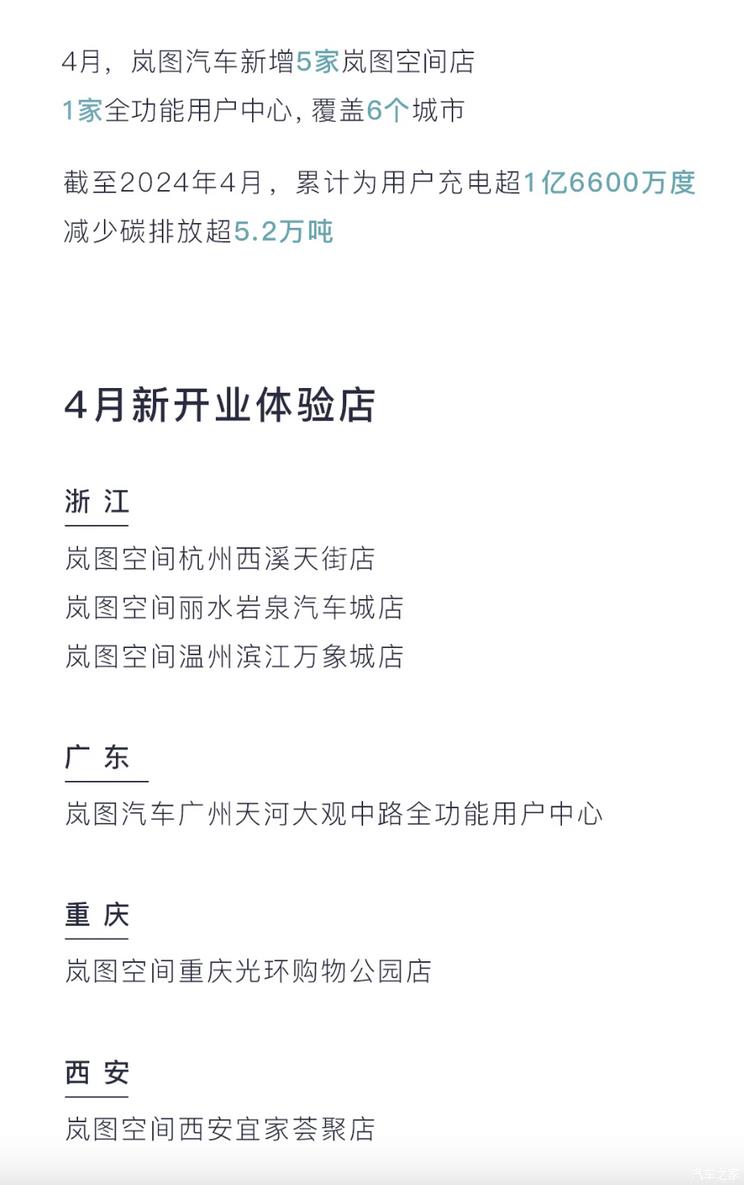
In addition, in April, Lantu Auto added five Lantu space stores and a full-featured user center covering six cities. By April, 2024, users had been charged more than 166 million kWh, and the carbon emissions from frying exceeded 52,000 tons.
At present, Lantu has set up 271 Lantu spaces and user centers in China, 31 Lantu spaces overseas, and its sales service network covers 126 cities around the world.
● Full text summary:
In April, the overall auto market boosted a lot, and the sales volume was red. It is expected that the good situation will continue until May, and more consumers will end the wait-and-see state. At the same time, it is expected that the price reduction promotion of car companies will be normalized. In April, we have seen many models upgrading their products in the name of launching new models, greatly lowering prices, and completing price reduction in disguise, and will maintain low prices for a long time. Mutual pricing will continue to be a hot topic this year. Once unattainable intelligent new energy vehicles will become more people-friendly. At the same time, new brands such as Weilai Ledao and Tucki MONA will be launched this year. Together with Xiaomi Automobile, there will be more cost-effective new energy vehicles in the second half of the year, and the market competition will be more intense. In the era of new energy, after the product is highly homogenized, the price of the coil will be inevitable at this stage, which is definitely good for consumers. (Text/car home Qin Chao)

